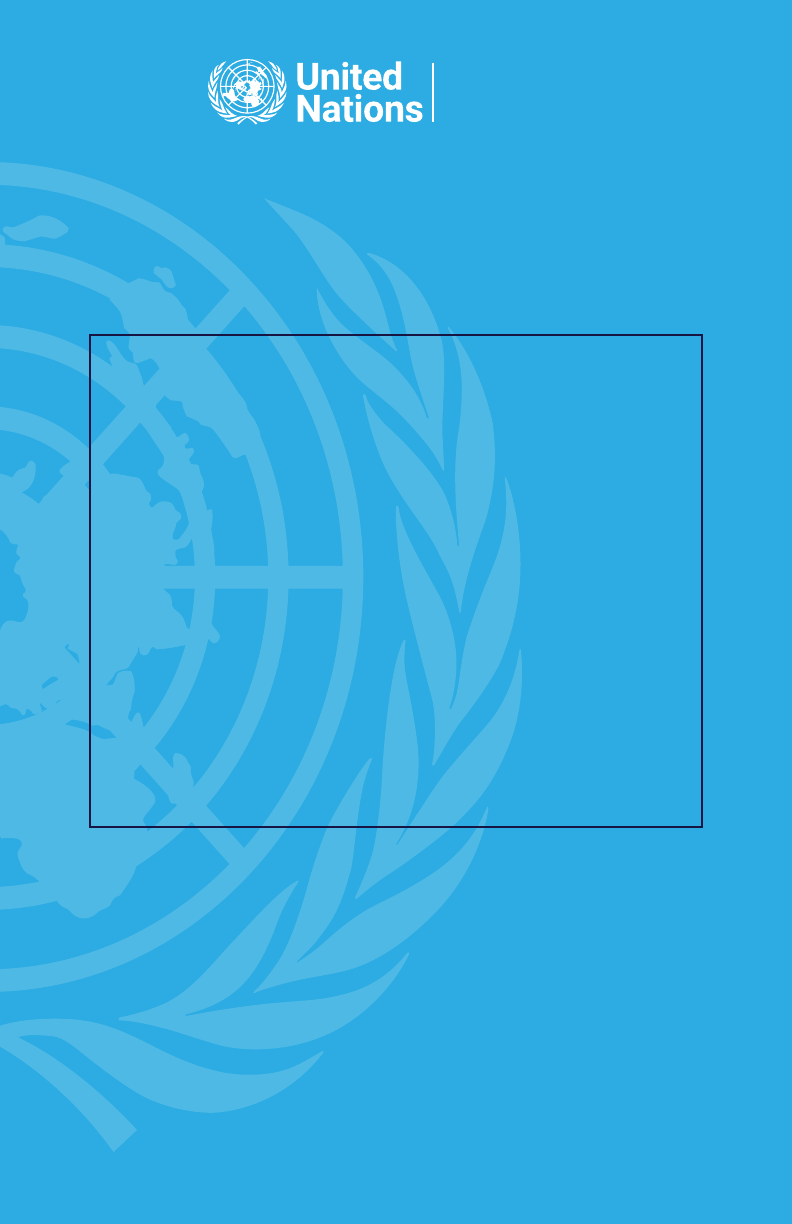
DO AND SMT
HANDBOOK
A GUIDE FOR DESIGNATED
OFFICIALS FOR SECURITY AND
SECURITY MANAGEMENT TEAMS
New Edition
Department
of Safety
and Security

2
Security for the United Nations, for a better world.
VISION
To enable United Nations system operations through
trusted security leadership and solutions.
MISSION

3
DO AND SMT
HANDBOOK
This handbook is provided exclusively for the use
of authorized United Nations personnel. It may not
be copied or reproduced by any means, manual,
electronic, photographic or photostatic, neither
may it be disassembled without the express written
permission of the United Nations Department
of Safety and Security (UNDSS). Copyright
with respect to all parts of this handbook and
attachments, including the name and logo of the
United Nations, remain the property of the United
Nations and may not, in whole or in part, be used
or referred to by any other person or organization
without express written permission from UNDSS.
This handbook will be revised and updated on
a regular basis. Feedback and comments are
therefore welcome, and should be sent to undss.

4

5
ABBREVIATIONS
FOREWORD
INTRODUCTION
UNSMS & IASMN MEMBERS
LEGAL AND POLICY FRAMEWORK
THE UNITED NATIONS SECURITY MANAGEMENT SYSTEM
SECURITY POLICY FRAMEWORK
UNITED NATIONS CONVENTIONS AND FRAMEWORK
OPERATIONAL GUIDANCE
SECURITY ARCHITECTURE IN-COUNTRY
SECURITY RISK MANAGEMENT
SPECIFIC SRM MEASURES
CRISIS MANAGEMENT
UN-WIDE CRISIS MANAGEMENT
SAFETY AND SECURITY CRISIS MANAGEMENT
CRISIS PREPAREDNESS
INCIDENTS TARGETING PERSONNEL AND PREMISES
SPECIFIC SECURITY CONSIDERATIONS
GENDER AND INCLUSIVITY
LOCALLY RECRUITED PERSONNEL
ABDUCTION OF PERSONNEL
ARREST AND DETENTION OF PERSONNEL
PHYSICAL SECURITY
EVENT SECURITY
PROTECTIVE SECURITY SERVICES
CBRN
PSYCHOSOCIAL SUPPORT
SECURITY OF IMPLEMENTING PARTNER NGOS
SECURITY COMMUNICATIONS
SAFETY
SECURITY ADMINISTRATION
SECURITY BUDGETS
DUTY STATION CLASSIFICATION
DANGER PAY
ROLE OF SENIOR UNDSS REPRESENTATIVE
UNDSS ORGANIZATION CHART
CONTENTS
1
2
3
4
5
6
7
8
9
10
11
16
17
19
20
27
33
37
38
41
46
48
50
51
52
53
54
56
57
58
58
60
61
61
62
66
67
70
71
72
74

6
ASC
ASMT
BOI
CATSU
CBRN
CISMU
CMT
CMWG
CSA
DO
DOS
DPO
DPPA
DRO
HLCM
IASMN
ICSC
IIH
JFA
JOC
LCSSB
OCB
OSH
P/C/SA
PC
PSA
SA
SFP
SIOC
SOP
SMT
SRM
SSAFE
TRIP
UNCT
UNSMIN
UNSMS
ABBREVIATIONS
Area Security Coordinator
Area Security Management Team
Board of Inquiry
Commercial Air Travel Safety Unit (of UNDSS)
Chemical, Biological, Radiological and Nuclear
Critical Incident Stress Management Unit (of UNDSS)
Crisis Management Team
Crisis Management Working Group
Chief Security Adviser
Designated Ocial
Department of Operational Support
Department of Peace Operations
Department of Political and Peacebuilding Affairs
Division of Regional Operations (of UNDSS)
High Level Committee on Management
Inter-Agency Security Management Network
International Civil Service Commission
Integrated Information Hub
Jointly Financed Activities
Joint Operations Centre
Locally Cost-Shared Security Budget
Operations Coordination Body
Occupational Safety and Health
Senior UNDSS representative (either a PSA, CSA or SA)
Programme Criticality
Principal Security Adviser
Security Adviser
Security Focal Point
Security Information and Operations Centre
Standard Operating Procedure
Security Management Team
Security Risk Management
Safe and Secure Approaches in Field Environments (training)
Travel Request Information Process
United Nations Country Team
United Nations Security Management Information Network
United Nations Security Management System

7
W
elcome to the DO and SMT
Handbook: A Guide for
Designated Ocials for
Security and Security Management
Teams. This Handbook is a convenient
reference to the policy and security
management framework provided
by the United Nations Security
Management System (UNSMS).
As Designated Ocials for Security and members of Security
Management Teams (SMTs), your roles are critical to the effective
management of the UNSMS. We rely on your leadership to enable
the safe and secure delivery of programmes for all UNSMS entities
in your Designated Area. We also depend on your judgement
and understanding to make critical decisions, often under
pressure and in sharply evolving contexts. To help you in this
role, you will be guided by your security experts in-country and
at headquarters, and through specialized trainings and products
such as this one. I am also ready to assist you in this crucial role
and welcome the chance to hear your concerns and challenges.
As the work of the United Nations has become increasingly fraught,
with personnel and operations an enduring target of violence, we
must work together to ensure we are prepared to meet safety and
security challenges head on. Through collaboration, communication
and an orientation towards practical solutions, we will strive to
enable the delivery of United Nations mandates and programmes.
UNDSS, and the wider UNSMS, stand ready to guide and support you.
Mr. Gilles Michaud
Under-Secretary-General for Safety and Security
September 2020
FOREWORD

8
T
his Handbook covers the main policies and procedures that
govern the United Nations Security Management System
(UNSMS). These policies are contained in the UNSMS Security
Policy Manual (“blue book”) and are complemented by detailed
guidelines compiled in the Security Management Operations
Manual (“red book”) and other specialized manuals. These are
made available through the United Nations Security Management
Information Network (UNSMIN) at www.unsmin.org, via the library
tab (sign-in credentials are obtained through UNDSS.)
UNSMS security professionals in the Designated Area will serve as
the best resource to support your security management functions.
UNDSS Headquarters offers further support through its specialized
functions. Finally, the USG UNDSS, as the principal adviser on safety
and security to the Secretary-General, stands ready to provide
leadership support and advice.
INTRODUCTION

9
ADB Asian Development Bank CTBTO Comprehensive Nuclear-Test-
Ban Treaty Organization DESA Department of Economic and Social
Affairs DOS Department of Operational Support DPO Department of
Peace Operations DPPA Department of Political and Peacebuilding
Affairs EBRD European Bank for Reconstruction and Development
FAO Food and Agriculture Organization IAEA International Atomic
Energy Agency ICAO International Civil Aviation Organization ICC
International Criminal Court ICJ International Court of Justice IFAD
International Fund for Agricultural Development ILO International
Labour Organization IMF International Monetary Fund IMO
International Maritime Organization IOM International Organization
for Migration IRMCT International Residual Mechanism for Criminal
Tribunals ISA International Seabed Authority ITC International
Trade Centre ITU International Telecommunication Union OCHA
Office for the Coordination of Humanitarian Affairs OHCHR Office
of the United Nations High Commissioner for Human Rights OPCW
Organization for the Prohibition of Chemical Weapons PAHO
Pan American Health Organization UNAIDS Joint United Nations
Programme on HIV/AIDS UNCTAD United Nations Conference
on Trade and Development UNDP United Nations Development
Programme UNDSS United Nations Department of Safety and
Security UNEP United Nations Environment Programme UNESCO
United Nations Educational, Scientific and Cultural Organization
UNFPA United Nations Population Fund UN-Habitat United Nations
Human Settlements Programme UNHCR Office of the United
Nations High Commissioner for Refugees UNICC United Nations
International Computing Center UNICEF United Nations Children’s
Fund UNIDO United Nations Industrial Development Organization
UNOCT United Nations Office of Counter-Terrorism UNODC United
Nations Office on Drugs and Crime UNOPS United Nations Office
for Project Services UNRWA United Nations Relief and Works
Agency for Palestine Refugees in the Near East UNU United Nations
University UNV United Nations Volunteers UN Women United
Nations Entity for Gender Equality and the Empowerment of Women
UNWTO United Nations World Tourism Organization UPU Universal
Postal Union WBG World Bank Group WFP World Food Programme
WHO World Health Organization WIPO World Intellectual Property
Organization WMO World Meteorological Organization WTO World
Trade Organization
UNSMS & IASMN Members

LEGAL & POLICY
FRAMEWORK
1
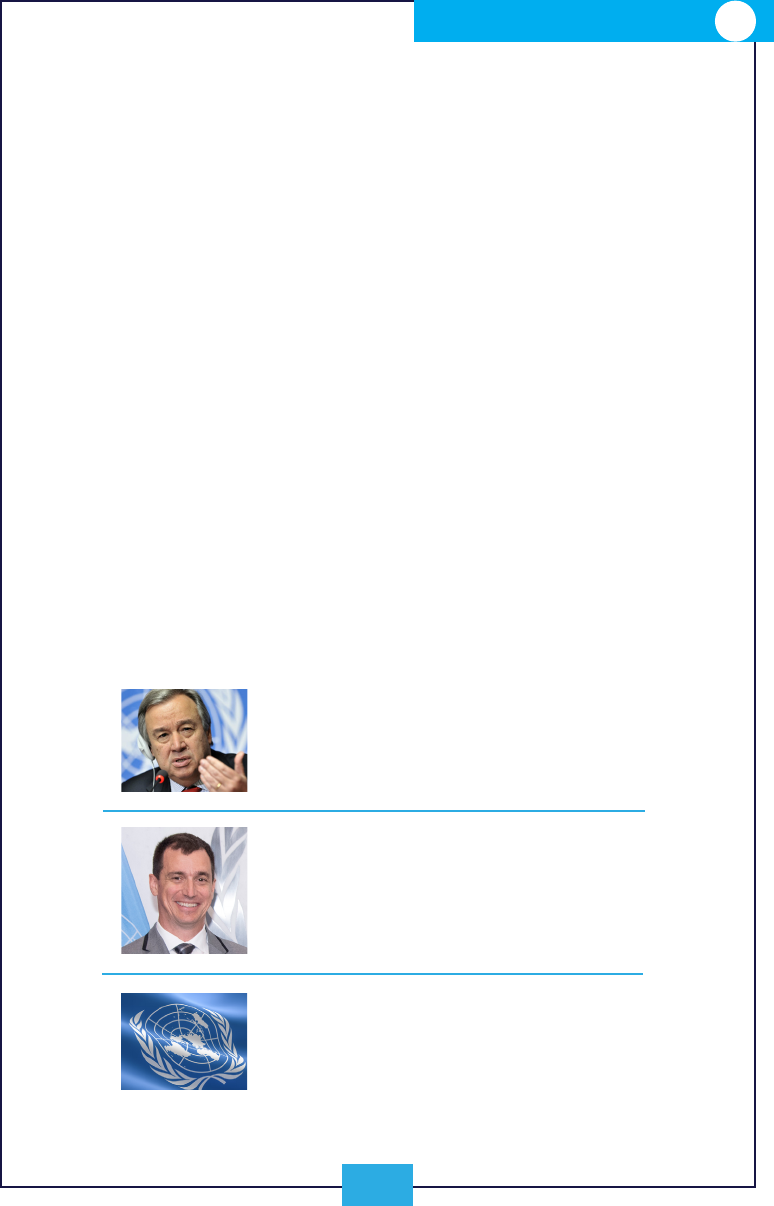
11
LEGAL AND POLICY FRAMEWORK
1
DO AND SMT HANDBOOK
Safety and Security Roles and Responsibilities in HQ
I
n the discharge of your security management duties, there are
a number of legal and policy documents with which you must
be familiar. These provide the framework to guide key decisions
impacting the safety and security of United Nations personnel.
THE UNITED NATIONS SECURITY
MANAGEMENT SYSTEM
The UNSMS is composed of all United Nations system organizations
and other international organizations that have signed a Memorandum
of Understanding with the UNSMS for the purposes of safety and
security. The UNSMS has over 50 member organizations and is led
by UNDSS under the executive authority of the USG UNDSS.
There are currently four international organizations that have signed
a Memorandum of Understanding with the United Nations for the
purposes of safety and security: Asian Development Bank, European
Bank for Reconstruction and Development, the International Criminal
Court and the International Organization for Migration.
Secretary-General
• Overall safety and security of UN personnel in HQ and eld
• Accountable to Member States
USG UNDSS
• Executive direction
• Overall responsibility for safety and security of UN personnel
at HQ and eld
• Accountable to the Secretary-General
• Chairs the IASMN
Executive Heads of UN Organizations
• Accountable to the Secretary-General
• Ensure the goals of UNSMS are met within their organization

12
DO AND SMT HANDBOOK
LEGAL AND POLICY FRAMEWORK
1
There are four essential policies with which any security decision
maker in the United Nations system should be familiar.
1. The Framework of Accountability for the UNSMS stipulates
that the DO is accountable to the Secretary-General, through the
USG UNDSS, and is responsible for the safety and security of United
Nations personnel, premises and assets in the Designated Area.
The Secretary-General delegates to the DO the requisite authority
to take decisions, subject to review of the USG UNDSS. The SMT,
chaired by the DO, advises the DO on all security-related matters.
These responsibilities are addressed in more detail in the following
chapters.
2. The Policy on Applicability for the UNSMS identies which
individuals fall under the scope of the UNSMS and are therefore
covered by United Nations security arrangements. They include
internationally and locally recruited personnel and their eligible
family members, interns, United Nations Volunteers and, generally,
consultants for United Nations entities. In practical terms, this
means that any individual who has signed a direct contractual
agreement with one of the UNSMS organizations falls under the
UNSMS.
UNDSS was established on 1 January 2005 pursuant to
General Assembly resolution A/RES/59/276, with a view
to unifying the disparate security components of the
existing Oce of the United Nations Security Coordinator
(known as UNSECOORD) and the Security and Safety
Services, including those in the regional commissions.
UNDSS manages a network of security advisers, analysts,
ocers and coordinators in more than 100 countries in
support of around 180,000 United Nations personnel,
400,000 dependants and 4,500 United Nations premises
worldwide.
Establishment of UNDSS

13
LEGAL AND POLICY FRAMEWORK
1
DO AND SMT HANDBOOK
In missions led by the Department of Peace Operations (DPO) or the
Department of Political and Peacebuilding Affairs (DPPA), police
and military personnel who are deployed individually all fall under
the UNSMS (i.e., contingent members are excluded), although their
family members are excluded.
Individuals recruited locally and paid by the hour are excluded from
this policy.
3. The Policy on Security Risk Management (SRM) outlines
the concept and principles which guide all decisions related to
security within the UNSMS. The SRM process is a structured and
risk-based decision-making tool. It guides the process to enable
programme delivery through the identication and assessment
of the threats to United Nations personnel, assets and operations
in a Designated Area, and assists in the identication of security
measures and procedures to reduce vulnerability and the level of
associated risk. This process supports the dicult risk decisions
the DO must take, in collaboration with the SMT, in regards to the
safety and security of United Nations personnel, including what
risks are deemed acceptable. The SRM is explained in detail on
page 27.
4. The Programme Criticality Framework is a system-wide
policy endorsed by the High-Level Committee on Management and
the Secretary-General’s Policy Executive Committee. The aim of
the Programme Criticality Framework is to assess programmatic
priorities in changing or volatile security situations to allow
decisions on acceptable risk. This decision is made by balancing the
“residual risk” of a programme against its assessed criticality. The
responsibility for Programme Criticality assessments lies with the
senior United Nations representative in-country (i.e., the Resident
Coordinator or Special Representative of the Secretary-General). Its
application is mandatory in environments of high or very high security
risk. However, assessments are also recommended as preparatory
measures in those countries with unpredictable or rapidly changing
security environments: such proactive assessments can facilitate
rapid decision-making if the security risks are suddenly elevated.
(Please see www.programmecriticality.org for more information.)
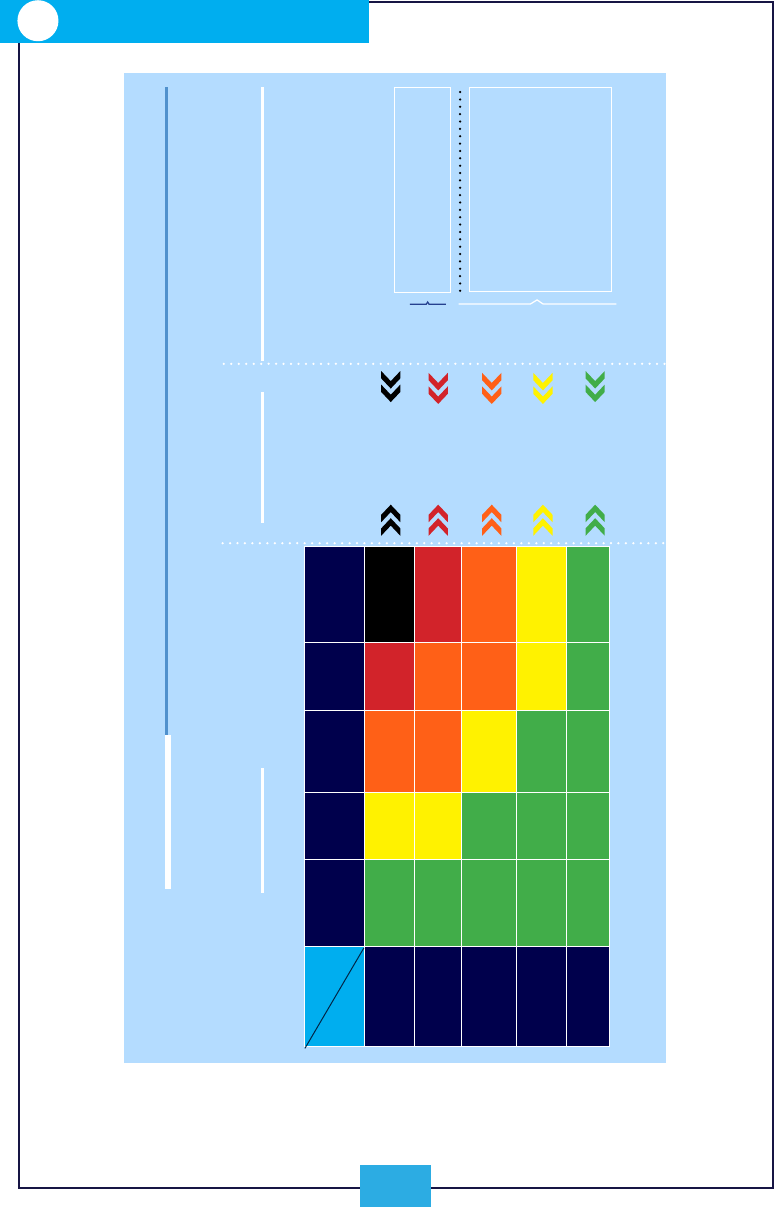
14
DO AND SMT HANDBOOK
LEGAL AND POLICY FRAMEWORK
1
Unacceptable
Very High
High
Medium
Low
N/A
PC1
PC2
PC3
PC4
- Life-saving activities (at scale)
- Any activity endorsed by the SG
Two rating Criteria
- Contribution to each in-country
UN strategic result
- Likelihood of implementation
Residual Risk
Programme Criticality Level
SRM Process
Acceptable Risk Model (PC)
IMPACT
LIKELIHOOD
NEGLIGIBLE MINOR MODERATE SEVERE CRITICAL
VERY LIKELY Low Medium High Very High Unacceptable
LIKELY Low Medium High High Very High
MODERATELY
LIKELY
Low Low Medium High High
UNLIKELY Low Low Low Medium Medium
VERY
UNLIKELY
Low Low Low Low Low
Fig. 1: The UNSMS Acceptable Risk Model compares Residual Risk and Programme
Criticality levels.

15
LEGAL AND POLICY FRAMEWORK
1
DO AND SMT HANDBOOK
HLCM
High Level Committee on
Management
IASMN
Working Groups
IASMN
Steering Group
IASMN
Inter-Agency Security
Management Network
UNSMS Policy-Making & the IASMN
Security management policies within the UNSMS are
initiated, developed and reviewed by the Inter-Agency
Security Management Network (IASMN), a specialized
network chaired by the USG UNDSS and composed of the
senior security managers of all UNSMS organizations.
The IASMN meets twice a year and is supported by a
Steering Group and thematic working groups. The
IASMN falls under the auspices of the High-Level
Committee on Management, one of three pillars of the
Chief Executives Board for Coordination chaired by the
Secretary-General. Security policies are promulgated
following endorsement by the HLCM. Therefore, these
are not “UNDSS policies”; they are system-wide policies
endorsed at the highest level of the United Nations
system. We usually refer to these policies as “UNSMS
policies”. The graphic below shows how the work of
each group on policy ts together.
Fig. 2: A representation of the UNSMS policy-making process. UNSMS
policies approved by the HLCM are generally drafted by IASMN working
groups.

16
DO AND SMT HANDBOOK
LEGAL AND POLICY FRAMEWORK
1
SECURITY POLICY FRAMEWORK
All UNSMS policy materials are subordinate to, and consistent with,
the legislative issuances of the inter-governmental bodies, United
Nations Staff Regulations and Rules and system-wide policies of the
Secretary-General. UNSMS policy material is endorsed at the highest
level of the United Nations system and is applicable system-wide.
Policy: commits UNSMS organizations and personnel to a set of
global principles and objectives. Compliance is mandatory.
Guidelines: offer additional practicalities of how to implement a
policy and may include good practices.
Manual: provides detailed technical instructions on how to carry out
specic tasks related to a security policy or guidelines.
Handbook: gives information on a policy area or assists a particular
audience in performing their role(s).
Aide-Memoire: offers a summary or outline of important policy
guidance. In some instances, this may be a template or another
document that should be updated for a Designated Area.
UNDSS Communiqué: used by USG UNDSS to send communications
across the UNSMS. Policies and Guidelines are always initially
promulgated through a UNDSS Communiqué. Communiqués are also
used to disseminate a variety of UNSMS operational messages such
as evacuation instructions, threat warnings or distribution of new
equipment standards.

17
LEGAL AND POLICY FRAMEWORK
1
DO AND SMT HANDBOOK
UNITED NATIONS CONVENTIONS
AND FRAMEWORK
The UNSMS policy on “Relations with Host Countries on Security
Issues” outlines the need for the DO, the SMT and United Nations
security professionals to review the host Government’s capacity to
carry out its responsibilities for protecting the United Nations, and
to identify, reinforce and supplement any shortfalls in this capacity.
The policy also identies key aspects of collaboration with the host
Government on security related issues. It is an essential part of the
responsibility of the DO to ensure that the UNDSS security team
establishes and maintains a dialogue and collaboration with the local
authorities. Another important aspect of the DO’s responsibility is
to pursue with the host Government that the perpetrators of crimes
against United Nations personnel are brought to justice by the host
Government, in accordance with relevant legal instruments.
Q. Do security policies vary between UN agencies?
If so, who is responsible for which security measures
are taken to protect personnel in the eld?
A. UN agencies, funds and programmes are members of the
UNSMS. As such, they participate in and contribute to the
development of all security policies and are bound by them.
There is only one set of approved UN security policies.
Where policies allow for exibility in implementation,
agencies, funds and programmes may have variances, but
the mandatory policy aspects must be adhered to by all.

18
DO AND SMT HANDBOOK
LEGAL AND POLICY FRAMEWORK
1
Legal and Policy Framework
1. United Nations Charter – articles 104 and 105
2. Conventions on Privileges and Immunities of the
United Nations (1946 and 1947)
3. Convention on Safety and Security of United Nations
Personnel and Associated Personnel (1994), and its
Optional Protocol (2005)
4. UNSMS Security Policy Manual (updated regularly
with new and revised policies)
5. Annual Resolutions of the General Assembly on the
“Safety and Security of Humanitarian Personnel and
Protection of United Nations Personnel”
Compliance with Security Policies and Procedures
To ensure that its policies remain robust, the UNSMS
has established a policy feedback loop that includes
the monitoring of compliance status. Compliance
monitoring consists of general and specic techniques
that may include self-assessment, peer reviews,
continuous document reviews and compliance audits.
The DO should report cases of non-compliance
to the applicable UNSMS organization, so that the
organization can take corrective actions, and inform
USG UNDSS to facilitate follow-up at the headquarters
level.

OPERATIONAL
GUIDANCE
2

20
DO AND SMT HANDBOOK
2
OPERATIONAL GUIDANCE
C
hapter 1 of this handbook outlined the legal and policy
frameworks for the day-to-day roles of DOs and SMTs. This
chapter explains the broad security architecture in-country
and provides an in-depth overview of the SRM process that guides
security decision-making.
SECURITY ARCHITECTURE IN-COUNTRY
The Framework of Accountability provides guidance on the roles
and responsibilities of all security actors in the UNSMS. DOs are
accountable to the Secretary-General, through the USG UNDSS, for
the safety and security of all individuals covered by the UNSMS in
their Designated Area.
The DO is required to nominate at least three persons that
could serve as DO a.i. Such nominees shall be heads of UNSMS
organizations at the Designated Area, members of the SMT and
accredited to the host Government. All nominated DOs a.i. shall
obtain clearance from their respective parent organizations before
accepting the DO’s nomination. Prior to any absence from the
Designated Area, DOs shall ensure that one of the appointed DOs
a.i. remains in the Area.
In this regard, the DO will be supported by a range of United Nations
security professionals and the SMT, as well as the USG UNDSS.
Security Management Team
The SMT provides advice and support to the DO on all security-
related matters and comprises the heads of all UNSMS entities/
organizations with presence in the Designated Area. These
representatives are accountable to the Secretary-General,
through their Executive Directors, for the safety and security of
all individuals of their organization.
The role of SMT members is to advise the DO on the particular
concerns of their organizations regarding security and
ensure that activities of their organizations are conducted in
compliance with the applicable decisions. They also ensure that
safety and security considerations are a core component of

21
OPERATIONAL GUIDANCE
2
DO AND SMT HANDBOOK
their programmes and are adequately funded at the local level,
and that their personnel comply with all related instructions and
requirements.
It is important that the DO provide effective leadership to the
SMT and chair the meeting in-person. Though decisions are
normally made in a consultative manner reecting the views and
recommendations of SMT members, the DO is responsible and
accountable for making the nal decision on security-related
issues. In the event that a rapid decision is required to avoid loss
of life or to resolve an impasse at the SMT level, the USG UNDSS
may convene the Executive Group on Security, comprised of
Executive Heads of a number of UNSMS organizations, to advise
and assist in rapidly resolving a security impasse. An Executive
Group on Security meeting may also be called should the DO
request the USG UNDSS to do so.
It is also important that the DO convene regular meetings of the
SMT, at a frequency determined by the SRM, and at least once
a year. Minutes of each SMT meeting must be prepared, shared
with SMT members for review and, when nalized, forwarded to
UNDSS Headquarters. All members must receive SMT training
prior to participating in the meetings.
The SMT comprises the head of each UNSMS organization
present in the Designated Area. In peace operations, where
the Head of Mission serves as the DO, the SMT may also
include heads of components, or oces, as specied by the
DO. Heads of military and police components of peacekeeping
missions are always members of the SMT.
Who is part of the SMT?

22
DO AND SMT HANDBOOK
2
OPERATIONAL GUIDANCE
Training for DOs & the SMT
Area Security Coordinators and Area SMTs
It is mandatory for DOs a.i., all members of SMTs and Area
Security Coordinators to complete training specic to their
security roles. At a minimum, the online SMT training module
must be completed, and a record of certication maintained.
DOs a.i. are also required to complete a mandatory security
orientation course at either New York Headquarters or
virtually, ideally prior to assuming their role in the country of
assignment. This mandatory training also applies to those
who have already been DOs for extended periods of time or
are changing duty stations.
In addition, there may be other training requirements at the
local level.
As a reminder, DOs and SMT members are accountable for
ensuring that all personnel complete the requisite mandatory
training BSAFE, as well as other training requirements
determined for the Designated Areas as per the SRM process.
Contrary to the earlier versions of the BSAFE training (Basic
and Advanced Security in the Field courses), there are no
limits on the course’s validity and, once completed, it does
not have to be retaken. Personnel may be encouraged,
however, to revisit the training to refresh their knowledge.
Area Security Coordinator
In a large Designated Area with locations far from the capital, the
DO, in consultation with the SMT, may appoint in writing an Area
Security Coordinator (ASC) for each area. The ASC is responsible
for coordinating security arrangements applicable to all
personnel, premises and assets in their areas of responsibility
(called “Security Area”).
The ASC is accountable to the DO for his or her security-related
responsibilities. The ASC must establish an Area Security
Management Team (ASMT) comprising of heads or senior
personnel of all UNSMS organizations in the Security Area, as
well as an Area Security Cell.

23
OPERATIONAL GUIDANCE
2
DO AND SMT HANDBOOK
Security Professionals
Various categories of security professionals are deployed to
assist the DO and the ASC in the discharge of their responsibilities:
• The Principal Security Adviser, Chief Security Adviser or
Security Adviser (P/C/SA) is a UNDSS staff member and
senior security professional appointed to advise the DO and
SMT in their respective security roles. They can have regional
functions and advise DOs and SMTs in several countries.
This senior UNDSS representative reports directly to the
DO and maintains a technical line of communication on
operational matters to UNDSS Headquarters in New York.
Minutes of ASMT meetings should be provided to the DO and
the SMT for further review and endorsement. The ASC and the
Area Security Management Team are essentially subordinate
versions of the DO and SMT.
A UNDSS ocer on duty during the Nelson Mandela Peace Summit./UN Photo

24
DO AND SMT HANDBOOK
2
OPERATIONAL GUIDANCE
• In integrated peacekeeping or special political missions,
the senior UNDSS representative also manages the security
section of the mission and the operational management
of security across the country. In some non-integrated
peacekeeping missions where the Head of Mission is the DO
for a specic Designated Area, the mission’s Chief Security
Ocer acts as the primary security adviser to the DO in the
absence of a UNDSS-appointed security professional.
• The senior UNDSS representative and Chief Security Ocer
directly supervise an Integrated Security Workforce (i.e.
security personnel from UNDSS and from the mission)
whose size varies depending on various factors including
size of mission, geography and risk. These include Field
Security Coordination Ocers, Security Information
Analysts, Security Operations Ocers, Mission Security
Ocers and Local Security Assistants. In very complex
environments, the security structure may be further
reinforced by a Security Information and Operations Centre
to perform analytic and coordinating functions.
• Single-Agency Security Ocers of UNSMS organizations
may be deployed to specic Designated Areas or with a
regional coverage to advise their organization and take
responsibility for security specic to their organization’s
activities. These Security Ocers are accountable to
their organization, although they do have an obligation
to support the Security Cell under the coordination of
the senior UNDSS representative. In the absence of a
UNDSS representative, Single-Agency Security Ocers
can be appointed by UNDSS as the Security Adviser
a.i., in consultation with their respective organization.
In Oces away from Headquarters, Regional Commissions
and International Tribunals, security functions are managed
by the Chief of Security and Safety Services. The Chief
is responsible for the management of Security and
Safety Services/Sections, including uniformed UNDSS
Security Ocers. In some locations, the USG UNDSS can
appoint the Chief of Security and Safety Services as the
Principal or Chief Security Adviser for a Designated Area.

25
OPERATIONAL GUIDANCE
2
DO AND SMT HANDBOOK
Security Cell
In order to ensure the ecient and effective use of resources and
ascertain that all Security Ocers at the Designated Area work
to further the SRM process, the senior UNDSS representative
establishes and chairs a Security Cell. The Security Cell includes
Single-Agency Security Ocers who advise on particular
concerns of their organization regarding security, as well as
local Security Focal Points of UNSMS entities.
In practice, and in locations where the senior UNDSS
representative has established a Security Cell, security-related
matters addressed at the SMT should rst be addressed at the
Security Cell level. With the agreement of the SMT member,
Security Cell members attend the SMT as observers.
Wardens
Wardens are not security professionals, yet they hold
specic security responsibilities. They are selected among
internationally and locally recruited personnel and appointed
in writing by the DO, in consultation with the SMT, to assist in
the implementation of the Area Security Plan. (Please see page
46 for more on the security plans). Wardens are accountable to
the DO for their security-related functions, irrespective of their
employing organization, and are responsible for communicating
with personnel, their eligible family members and visitors
in times of crisis. The Warden System can be zone-based
(responsible for communicating on security with all personnel in
a specic geographic area) or organization-based (responsible
for communicating on security within their organization).
United Nations Personnel
All United Nations personnel in the Designated Area have
a responsibility to abide by security policies, guidelines,
directives, plans and procedures of the UNSMS, in accordance
with the Framework of Accountability. United Nations personnel
are those covered under the Applicability Policy. The leadership

26
DO AND SMT HANDBOOK
2
OPERATIONAL GUIDANCE
of the DO, as well as of heads of UNSMS organizations, is
instrumental to cultivating a “security culture” in-country. This
means leadership teams must ensure that personnel familiarize
themselves with security management information relevant
to their location and duty station, attend and complete the
necessary security training and required briengs, and report all
security incidents in a timely manner. Finally, all United Nations
personnel must conduct themselves in a manner that will not
endanger their own safety and security or that of others.
The DO is responsible for the provision of Area SRM processes,
as well as ad-hoc SRM processes. Although the senior UNDSS
representative and the UNDSS team will guide these processes,
DOs are expected to be familiar with them and lead the SMT
to endorse the nal product. In each country, a number of
SRM processes may be completed depending on the size and
complexity of the country and United Nations presence.
There are nine steps to the SRM process, outlined in the
following pages. The mandatory SMT training also provides
further information on this process, and the DO is encouraged
to consult with the senior UNDSS representative for additional
expertise and advice.
Our Security Obligations
1. Familiarize ourselves with security information provided
at the location
2. Obtain security clearance prior to traveling
3. Attend security briengs
4. Know our wardens and security professionals
5. Be appropriately equipped for service at the duty station
6. Comply with all UNSMS regulations and procedures, both
on/off duty
7. Comport ourselves in a manner which will not endanger
our safety and security or that of others
8. Report all security incidents in a timely manner
9. Complete BSAFE
10. Complete security training relevant to level and role
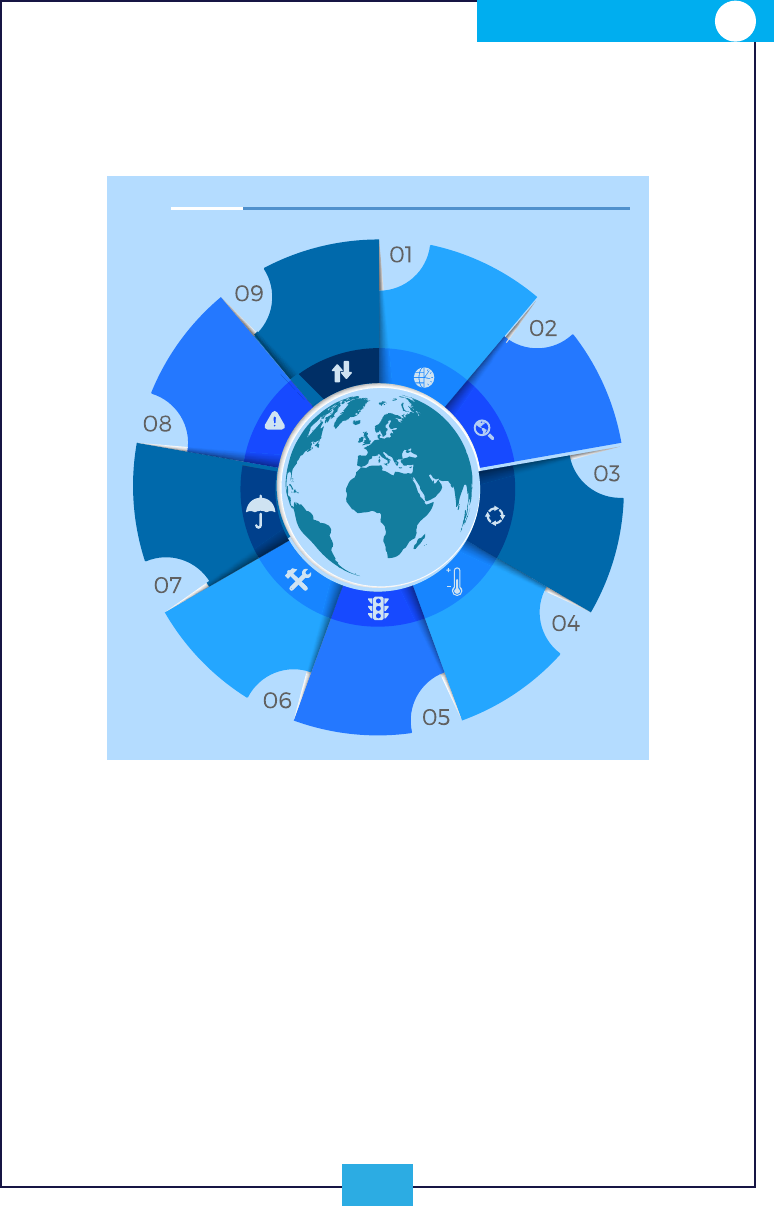
27
OPERATIONAL GUIDANCE
2
DO AND SMT HANDBOOK
SRM Process
Step 1
Step 2
Step 3
Step 4
Step 5
Step 6
Step 7
Step 8
Step 9
ACCEPTABLE
RISK
REVIEW
SITUATIONAL
ANALYSIS
PROGRAMME
ASSESSMENT
THREAT
ASSESSMENT
SECURITY RISK
ASSESSMENT
SRM
MEASURES
SRM
IMPLEMENTATION
GEOGRAPHICAL
SCOPE AND
TIMEFRAME
SECURITY RISK MANAGEMENT
Security Risk Management is the UNSMS tool to identify, analyze
and manage safety and security risks to United Nations personnel,
assets and operations.
The SRM process is guided by a UNSMS policy, and supported by a
manual which provides step-by step guidance to security personnel
on the process. This approach was rst established in 2004 and
last updated in 2019 with additional guidelines, training tools and
templates.
Fig 3: The SRM process is a structured, problem-solving mechanism that consists of
nine steps.

28
DO AND SMT HANDBOOK
2
OPERATIONAL GUIDANCE
Setting the Geographical Scope and Timeframe
The initial step in the SRM process is establishing the geography
and timeframe of the SRM. This comprises a Designated Area, a
Security Area (usually the area of responsibility of an ASC) and
any specic SRM Area. An SRM area is determined at the country
level by the SMT, and is usually an area of homogenous threats
for which a specic assessment is carried out (such as a conict
area). The SRM Area is the geographical scope at which the DO
applies the SRM process. The timeframe for each SRM process
may be determined by an event (such as an election period), or
within a reasonable review period (usually 3, 6 or 12 months).
Situational Analysis
A common understanding of the security situation is vital for
responsible decision makers. The situational analysis considers
the political, economic, social and environmental status in each
area, and examines how developments in these areas may
impact the safety and security of United Nations activities. It
also considers the United Nations mandate and/or strategic
priorities and how these could potentially affect the security
situation or United Nations personnel, assets and operations, as
well as threat groups/actors.
Programme Assessment
This assessment is the process by which the goals and
specic implementation activities of all UNSMS organizations
in-country are formally identied and assessed for any threat-
related implications. Sucient details must be provided about
the programmes to be delivered - both generally (such as within
over-arching mission goals) and specic to each programme.
Risk-Based vs Threat-Based?
It is very important to understand that the UNSMS is risk-
based, not threat-based. While threats are assessed as part
of the process, decisions are taken based on the assessment
of risk.
Step 1
Step 2
Step 3

29
OPERATIONAL GUIDANCE
2
DO AND SMT HANDBOOK
Threat Assessment
The Threat Assessment is the assessment of those actors
and actions in the SRM area that may potentially cause harm
to the United Nations system. These are assessed in the
following categories: Armed Conict, Terrorism, Crime and
Civil Unrest. The intent and capabilities of the relevant threat
actors are identied and assessed, along with the Inhibiting
Context, which acts as a “restrainer” of the threats. In locations
where UNDSS Security Information Analysts are present, their
assessments will form a vital part of this process. The Threat
Assessment ends with event descriptions, which are essentially
forecasts for how specic threats might occur in the future.
Security Risk Assessment
The Security Risk Assessment is the process by which the
different threats of the United Nations presence and activities in-
country are assessed against the existing vulnerabilities in order
to determine the likelihood of a harmful threat event occurring,
and the impact this may have on United Nations personnel,
assets and operations. A risk matrix is used to determine the
overall risk.
Security Risk Management Measures
This step is the process by which measures and procedures to
lower the risks - called SRM measures - are decided. This then
results in the residual risk. All measures identied must be
Step 4
Step 5
Step 6
Gender considerations in the SRM
The SRM must be gender sensitive and gender-responsive.
All gender-based threats, risks and vulnerabilities should
be considered in the SRM process, including during risk
analysis, identifying SRM measures for gender-related
security incidents, managing stress and reporting gender-
related security incidents. SRM measures, including for
residences, should be reviewed on a regular basis with a
gender perspective.

30
DO AND SMT HANDBOOK
2
OPERATIONAL GUIDANCE
directly linked to the preceding assessment, assisting to reduce
either the likelihood (prevention) or the impact (mitigation)
of an event, or both. SRM measures may include information,
training, briengs, specialist resources, equipment, physical
improvements to premises or facilities, or procedural changes.
When selecting SRM measures, it is important to consider the
time, cost and potential adverse impact of any decisions taken.
Each measure will have strengths and weaknesses. The nal
decision of the DO should take these into account.
SRM Implementation
Once a decision is made, the SRM measures must be
implemented, including through the allocation of resources
where required. If the SRM measures are not implemented
effectively, the SRM process fails, as risk is not being managed
and reduced. The leadership of the DO and the implementation
by the SMT is vital to ensuring the effective management of
security risks.
Acceptable Risk Decisions
ACCEPTABLE RISK DECISION = BALANCING RISK
AGAINST CRITICALITY
a. Do not accept unnecessary risk
b. Accept risk when benets outweigh costs
c. Make risk management decisions at the right level
Step 7
Which measures are mandatory?
SRM measures that have been approved by the DO, on the
recommendation of the SMT, are mandatory in the SRM Area.
These approved SRM measures are sometimes referred to as
MOSS.

31
OPERATIONAL GUIDANCE
2
DO AND SMT HANDBOOK
Acceptable Risk
The Acceptable Risk Model includes the Programme Criticality
Framework, as briey introduced on pages 13 and 14. This
model has three important principles to aid in the balancing of
risks, highlighted in the box on page 30.
Under the Acceptable Risk Model, whether the risk of a given
programme activity is acceptable will depend on the criticality
of a programme (as determined by the United Nations Country
Team (UNCT) through a Programme Criticality exercise),
considered against the existing risk (as determined by the SRM
process outlined above.) As Resident Coordinator/Humanitarian
Coordinator or the Special Representative of the Secretary
General, the DO is responsible for ensuring the Programme
Criticality process has been carried out. The DO is also
responsible for ensuring that, when the risk is high or very high,
Fig 4: The approval of SRM measures follows a multi-step process. UNDSS
Headquarters Desk Ocers maintain oversight throughout to provide support where
required or requested.
Considering advice of SMT members,
DO decides at SMT meeting whether to approve SRM.
SRM Measures will become MOSS for Designated Area.
DO decides on SRM
SMT members have minimum four weeks to consider measures.
At this time they seek endorsement, support and advice from HQs.
SMT considers SRM
Senior UNDSS security officer in-country presents SRM Measures to
DO and SMT as part of SRM process for each Designated Area.
UNDSS presents SRM
Step 8

32
DO AND SMT HANDBOOK
2
OPERATIONAL GUIDANCE
the correct approvals are sought and received for programme
activity depending on the levels of risk.
Follow up and Review
The purpose of monitoring and evaluating the SRM process is
to assess and improve the effectiveness of the SRM measures,
or to remove or downgrade the measures as necessary. This
process can take place through routine monitoring by the SMT,
or through UNDSS internal processes such as spot checks or
review by the UNDSS DRO Desk Ocers.
Step 9
Acceptance
The SRM should take into account acceptance, which can
be considered in the situational analysis, the programme
and threat assessments and the security risk assessment
steps of the process. The SMT should encourage the
implementation of measures such as communication
campaigns, stakeholder/beneciary meetings, negotiations,
or other engagement with threat actors, where appropriate,
in order to help secure acceptance. Acceptance can be
dened as “good relations and consent as part of a security
management strategy with local communities, parties to the
conict, and other relevant stakeholders and obtaining their
acceptance and consent for the humanitarian organization’s
presence and its work.” Its goal is to facilitate programme
delivery.

33
OPERATIONAL GUIDANCE
2
DO AND SMT HANDBOOK
SPECIFIC SRM MEASURES
The results of the SRM may lead to any number of risk management
measures that require implementation. There are four main
strategies for managing risk (below).
Of these, measures to avoid risk, including alternate work modalities
and personnel and/or family restrictions, may be considered on
a temporary basis. These measures have considerable physical
and administrative impact to United Nations personnel and/or
programmes and, as such, the DO and SMT should be familiar with
the terms and the administrative implications, as highlighted below.
Alternate Work Modalities: These refer to measures which limit or
totally remove the number of personnel or family members present
during working hours at a specic location(s) with the view to limit or
remove their exposure to unacceptable risk. Such measures could
include: temporarily limiting the number of personnel at a United
Nations premises, temporarily closing oces or establishing work-
from-home arrangements.
Personnel and/or Family Restrictions: Temporary restrictions are
placed on the presence of any or all personnel and/or eligible family
members of United Nations internationally recruited personnel at a
given location or area. They can include relocation or evacuation,
as follows.
Main Strategies for Managing Risk
• Accept the risk (no further action)
• Control the risk (using prevention and/or mitigation
measures)
• Avoid the risk (temporarily distance the target from the
threat)
• Transfer the risk (insurance, sub-contracts or other
measures)

34
DO AND SMT HANDBOOK
2
OPERATIONAL GUIDANCE
• Relocation: Relocation is the ocial movement of any
personnel or eligible dependants from their normal place
of assignment or place of work to another location within
their country of assignment for the purpose of avoiding
unacceptable risk. Relocation can be applied to all
personnel and eligible family members. Entitlements are
applicable.
• Evacuation: Evacuation is the ocial movement of
international personnel and their eligible dependants from
their place of assignment to a location outside of their
country of assignment (safe haven country, home country
or third country). It may apply to locally recruited personnel
in exceptional circumstances and with the approval
of the Secretary-General. Entitlements are applicable.
The decision to relocate and/or evacuate is submitted
through the USG UNDSS to the Secretary-General on the
recommendation of the DO. In the event of an evacuation,
the USG UNDSS will distribute an All Agency Communiqué
to advise of the details, and will notify UNSMS entities of
any change or cessation of the relocation/evacuation.
In regards to the entitlements due to evacuation, individual parent
organizations are responsible for all nancial arrangements,
including the payment of salary advances, allowances or other
essential payments to their personnel as necessary. Further,
individual organizations may have additional provisions and
guidance for their personnel in the event of relocation or evacuation.
For example, representatives of organizations participating in the
UNSMS may institute Alternate Work Modalities solely for their
personnel in response to agency-specic risks and inform the SMT
and the senior UNDSS representative.
Personnel Evacuated from Kitchanga, North Kivu./UN Photo

35
OPERATIONAL GUIDANCE
2
DO AND SMT HANDBOOK
Evacuation of United Nations Personnel from Yemen
Case Study: March 2015
The evacuation of United Nations personnel from Yemen
was implemented after the intense aerial bombardment
of various targets in the country on 25 March 2015.
International UNSMS personnel were evacuated from
Aden, Al Hudaydah and Sana’a to neighboring countries
(Djibouti, Egypt and Ethiopia) in the following days. The
review of the event identied lessons and best practices
in relation to the crisis response, security arrangements
and evacuation procedures.
1. Comprehensive and detailed security planning is
essential in strengthening the level of preparedness. The
evacuation plan should contain a detailed description
of the arrangements, alternative triggers and means of
evacuation to allow evacuations to be implemented in an
organized and coordinated manner.
2. Effective implementation of SRM measures to lower
the residual risk is essential for continued UN presence
and continued programme operation. The purpose of
authorizing a small humanitarian coordination group of
international personnel to remain on the ground was to
coordinate critical humanitarian activities, in line with
PC1 activities. However, operations cannot be conducted
if there is no investment in, and implementation of, risk
management measures.
3. Clearly dened roles and responsibilities of personnel
involved during the evacuation, including the support
by security professionals of UNSMS organizations, are
crucial for the ecient management of a large number
of personnel at concentration points. This includes the
timely appointment of the SA a.i. and the Deputy SA a.i.
and the delegation of responsibility to locally recruited
personnel to enable structured liaison and clear chain of
accountability for security arrangements.
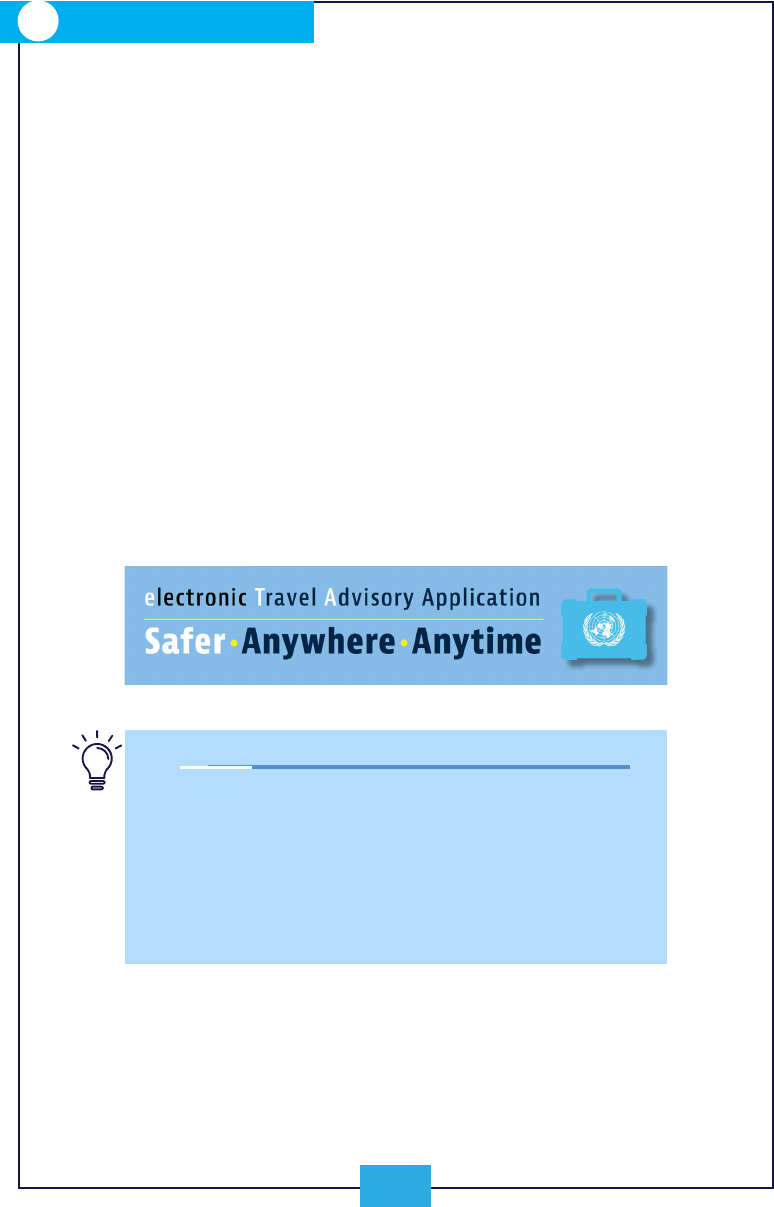
36
DO AND SMT HANDBOOK
2
OPERATIONAL GUIDANCE
The eTA app
In 2019, UNDSS released an application called eTA,
which provides resources such as security clearance
information and travel advisories for personnel of United
Nations departments, agencies, funds and programmes.
The application is available to all UN personnel. Its use
is approved by the DO at the local level through the SRM
process.
TRIP: Security Clearance
It is mandatory for the DO to manage security clearance
procedures for internal and external travel to the Designated
Area. To assist with this responsibility, UNDSS manages a web-
based system called the Travel Request Information Process
(TRIP). Security clearance procedures are required so that the DO
can monitor the location and number of United Nations system
personnel and eligible family members, ensure they are included
in the Country Security Plan and to communicate important
security information in the event of a crisis or emergency. DOs
may further delegate their authority to grant security clearances,
generally to the senior-most security professional directly
supporting them.
While this is not mandatory, personnel are encouraged to record
personal travels in TRIP so that they may receive assistance in
a crisis.

CRISIS
MANAGEMENT
3

38
DO AND SMT HANDBOOK
3
CRISIS MANAGEMENT
T
he preceding chapters outlined the regular security duties
and responsibilities of the DO and the SMT. This chapter lays
out the practical steps to take in case of a safety and security
crisis, as well as the necessary advance preparations.
The effective management of security crises is a crucial component
of the leadership of the DO supported by the SMT. This responsibility
includes ensuring appropriate preparation and response in the
event of a security crisis impacting United Nations personnel. DOs
shall make every effort to ensure that all preparedness measures
for security crises are undertaken in the Designated Area in line with
the level of threat and security risk.
UN-WIDE CRISIS MANAGEMENT
Crisis management across the organization is guided by the United
Nations Crisis Management Policy (2016, revised 2018). This policy
species that the senior-most UN ocial in country is responsible
and accountable for coordinating the management of the UN
response to the crisis in country. Depending on the nature of the
crisis, different UN entities have coordinating responsibilities.
UNDSS coordinates the crisis response for major safety and
security incidents and/or hostage incidents. Other types of crises
are coordinated by different entities: humanitarian crisis situations
are coordinated by the Emergency Relief Coordinator through the
United Nations Oce for the Coordination of Humanitarian Affairs;
crisis in peace operations are managed by the Department of Peace
Operations (DPO) or the Department of Political and Peacebuilding
Affairs (DPPA); the Oce of the United Nations High Commissioner
for Human Rights leads crisis in the event of grave violations of
human rights; and serious health emergencies rising to the level of
Public Health Emergency of International Concern are coordinated
by the World Health Organization.
The United Nations Crisis Management Policy is overarching and
strategic. It explains how UN actors should coordinate to respond
collectively to complex situations that require a multidisciplinary
approach. The Guidelines on Management of Safety and Security
Crisis Situations are in line with the system-wide policy and provide
operational guidance to the UNSMS.

39
CRISIS MANAGEMENT
3
DO AND SMT HANDBOOK
What’s the dierence between the UNSMS guidelines and
the system-wide policy?
The policy is strategic, while the guidelines are operational.
The policy also applies to all crisis situations, while the
guidelines are specic to the management of safety and
security crises.
Other lead entities have promulgated Standard Operating Procedures
(SOPs) to guide crisis arrangements at HQ (SOP on Headquarters
Crisis Response in Support of Peacekeeping Operations and SOP on
DPA [now DPPA] Headquarters Arrangements in support of Crisis
Response at the Field Level).
Effective leadership in crisis management:
Take charge quickly and rmly, using your crisis team to best
effect to provide advice and management on aspects where
you lack knowledge;
Make sure you have good situational awareness: what is
happening, why it is happening and what may happen next;
Be clear on your objectives and priorities; review them
regularly to adapt to a changing situation;
Accelerate decision-making to achieve timely, effective
decisions; ensure concurrent activity to achieve rapid action;
Give clear direction and guidance; assign clear responsibilities
for tasks with deadlines;
Focus at strategic and operational level, not detailed
discussions at subordinate level;
Instill a sense of urgency but also inspire condence and
remain calm.

40
DO AND SMT HANDBOOK
3
CRISIS MANAGEMENT
MANAGEMENT OF SAFETY AND
SECURITY CRISES
Depending on where the crisis situation is unfolding, either the
DO or ASC will function as the Crisis Manager (except for hostage
incidents). The Crisis Manager has the responsibility and requisite
authority to make critical decisions on the management and
response to safety and security crisis situations. The DO must
convene a Crisis Management Team within 24 hours following the
event of a safety or security crisis, until the emergency is resolved.
What constitutes a “crisis”?
A crisis is dened as an incident or situation, whether natural
or human-made, that due to its magnitude, complexity
or gravity of potential consequence, requires a UN-wide
coordinated multi-disciplinary response. Examples include
natural disasters, inter/intrastate conicts, acts of terrorism,
pandemics or reputational issues, such as multiple cases of
sexual exploitation and abuse.
What dierentiates a “safety* and security crisis” from
other types of crises?
Safety and security crisis is dened as an incident or
situation, whether natural or human-made, that due to its
magnitude, complexity or gravity of potential consequences
presents an exceptional risk to the safety and security of
UNSMS personnel, premises and assets. Often, safety and
security crisis situations are part of broader political, military
or humanitarian crises. In such complex contingencies, all
United Nations crisis management pillars, including safety
and security, must work together.
*The UNSMS covers three areas of safety: re, road and air travel safety.

41
CRISIS MANAGEMENT
3
DO AND SMT HANDBOOK
The Crisis Management Team will implement and coordinate
decisions made by the Crisis Manager. To coordinate specic
operational aspects of the crisis response, the DO may also
designate a Crisis Coordinator. In country team settings, where the
Resident Coordinator or Executive Director is the designated crisis
manager, the Principal/Chief or Security Adviser is designated as
the Crisis Coordinator.
Finally, to support the Crisis Management Team and help coordinate,
a Crisis Coordination Centre may also be established and equipped
with adequate communications systems. As noted earlier in the
chapter, UNDSS coordinates the crisis response for major safety
and security incidents.
In the event a rapid decision is required to avoid loss of life or to
resolve an impasse at the SMT level, the USG UNDSS may convene
the Executive Group on Security to assist in decision-making.
While the above-mentioned arrangements are applicable to all
types of United Nations eld presence, specic crisis management
eld architecture may vary depending on the setting. The diagram
on page 43 shows arrangements in a UN Country Team (vs. a UN
peace mission) scenario.
One of two civilian staff members with the African Union-United Nations Hybrid
Operation in Darfur (UNAMID) kidnapped in West Darfur arrives at El Fasher Airport.
/UN Photo

42
DO AND SMT HANDBOOK
3
CRISIS MANAGEMENT
For Peace Operations
In countries/areas where peacekeeping operations or integrated
special political missions are deployed, the mission Chief of
Staff is generally designated as Crisis Coordinator.
In countries/areas where non-integrated special political
missions are present, the mission Chief of Staff is normally
the designated Crisis Coordinator, if the Head of Mission is the
designated Crisis Manager.
The Crisis Coordinator convenes and chairs an Operations
Coordination Body (OCB), also referred to as the Crisis
Management Working Group (CMWG). The OCB/CMWG
is a working-level, cross-component body responsible for
supporting the Crisis Coordinator in all relevant tasks, such as
supporting day-to-day crisis response activities, making policy
recommendations and ensuring common messaging. The Crisis
Coordinator acts as the link with the Crisis Manager and CMT to
ensure that crisis management objectives are established and
achieved. Existing coordination bodies can be designated as
the OCB/CMWG during a crisis to avoid a proliferation of intra-
mission coordination mechanisms.
The Crisis Manager and the Crisis Coordinator are supported
by a secretariat for crisis management arrangements. In
peacekeeping operations, the secretariat role is undertaken
by the mission’s Joint Operations Centre (JOC), where one
exists, or an equivalent mission component designated by the
Crisis Manager. In integrated special political missions, the
secretariat role may be undertaken by the mission’s Integrated
Information Hub, where one exists, or an equivalent mission
component designated by the Crisis Manager such as the oce
of the Chief of Staff or the Security Information and Operations
Centre (SIOC).
In the non-integrated special political mission setting, a
designated structure, for example the Integrated Information
Hub (IIH) or the SIOC, serves as a 24/7 integrated information
and reporting focal point and as the secretariat for the duration
of the crisis. The JOC/IIH/SIOC, or a designated structure with
similar functions and adequate capability, provides secretariat
support for CMT and/or OCB/CMWG meetings, ensures 24/7
monitoring of and regular reporting on the crisis, acts as the
integrated information centre for all crisis-related information,
and keeps UNHQ updated via the UN Operations and Crisis
Centre and, as required, the respective regional desk of the
Regional Division in the DPPA-DPO Regional Structure.

43
CRISIS MANAGEMENT
3
DO AND SMT HANDBOOK
DO Crisis Management Response Actions
Activate Crisis Management response and inform USG
UNDSS;
Assume role of Crisis Manager or, where appropriate,
assign ASC to do so;
Establish Crisis Management Team and designate
Crisis Coordinator;
Implement Security Plans;
Set up crisis management reporting and information
platform (Crisis Coordination Centre or equivalent).
Information and Engagement
DOs and UNSMS organizations must include all personnel
- nationally and internationally recruited - in security
planning, as well as inform all of them of what assistance
can be provided by the UNSMS in times of crisis.
Fig. 5: Crisis management architecture in a Country Team Setting
ADVISES
SMT
P/C/SA
DO
CRISIS MANAGER
(DO or ASG)
CRISIS
COORDINATOR
NORMALLY P/C/CSA
DECISIONS
OPERATIONAL
MANAGEMENT
IMPLEMENTATION
TASKS
Crisis Management Team
(UNSMS orgs, experts)
RUNS
Crisis Coordinator Center
CRISIS MANAGEMENT ARCHITECTURE
Country Team setting

44
DO AND SMT HANDBOOK
3
CRISIS MANAGEMENT
Activating Crisis Management Operations
Security crisis management operations are activated whenever
the security situation is (or is likely to be) such that the security
management requirements exceed the ability of the normal
security structures, capacity, processes or procedures to
manage the response effectively. They should be activated
immediately in the aftermath of critical safety and security
incidents affecting UNSMS personnel, including those resulting
from natural disasters, aviation catastrophes, sudden spark of
military hostilities, mass casualty or hostage incidents. They
should be activated partially in situations with developing
political, military, humanitarian crisis or civil unrests, when
severe safety and security consequences to UNSMS personnel
are expected or cannot be ruled out, or where the UNSMS
operates in an environment of critical security incidents or
threats of such incidents.
Information Management
It is important that, during the crisis, relevant information is
collected, collated and disseminated to decision-makers both in
the eld and at headquarters through dedicated channels.
Operational aims of crisis management and response:
Save lives and protect UNSMS personnel
Protect UNSMS premises and assets
Minimize the impact of safety and security crisis on UN
programmes and activities
Ensure preparedness and recovery from impact of safety
and security crisis
Ensure return to UN programme delivery

45
CRISIS MANAGEMENT
3
DO AND SMT HANDBOOK
CRISIS PREPAREDNESS
Managing safety and security crisis situations in the eld effectively
depends on the level of crisis preparedness achieved through
implementing UNSMS policies and guidelines. Crisis preparation
should also include Saving Lives Together partners. This will enhance
multi-level cooperation, security awareness and build response
capacity of partners through enhanced information sharing and
shared training initiatives. See page 61 for more information.
Crisis Management in Integrated Mission Settings
Case Study: South Sudan
The crisis that took place in Juba, South Sudan, from 8 to
11 July 2016, presented several key lessons which can be
implemented to greatly increase effectiveness in emergency
preparedness planning, respective training and coordination
and implementation of plans in integrated mission settings.
Planning should include a dedicated focal point from national
security; clarication of the command and control structure and
role distribution; and, in addition, be subjected to continuous
review to ensure improvement of the planning processes.
Planning and preparing for large numbers of internally displaced
people entering UN facilities is a critical element of crisis
management planning.
Mission wide crisis management preparedness can be achieved
through training exercises and rehearsals using scenarios and
integrating all necessary UN actors. Greater security training
outreach to partners as advocated in the Saving Lives Together
framework will improve response eciency during management
of crises. Besides making specic provisions for the potential
unique security risks to female personnel in a crisis, any needs
assessment of training activities must also be cognizant of
security risks related to gender. Relevant and targeted training
to those identied at greater risk remains both an essential
mitigation and prevention strategy. Safe and Secure Approaches
in Field Environments (SSAFE) training is one area of training
that develops preparedness for all personnel. Personnel
expressly indicated the value of having received SSAFE training
in advance of the 2016 crisis.
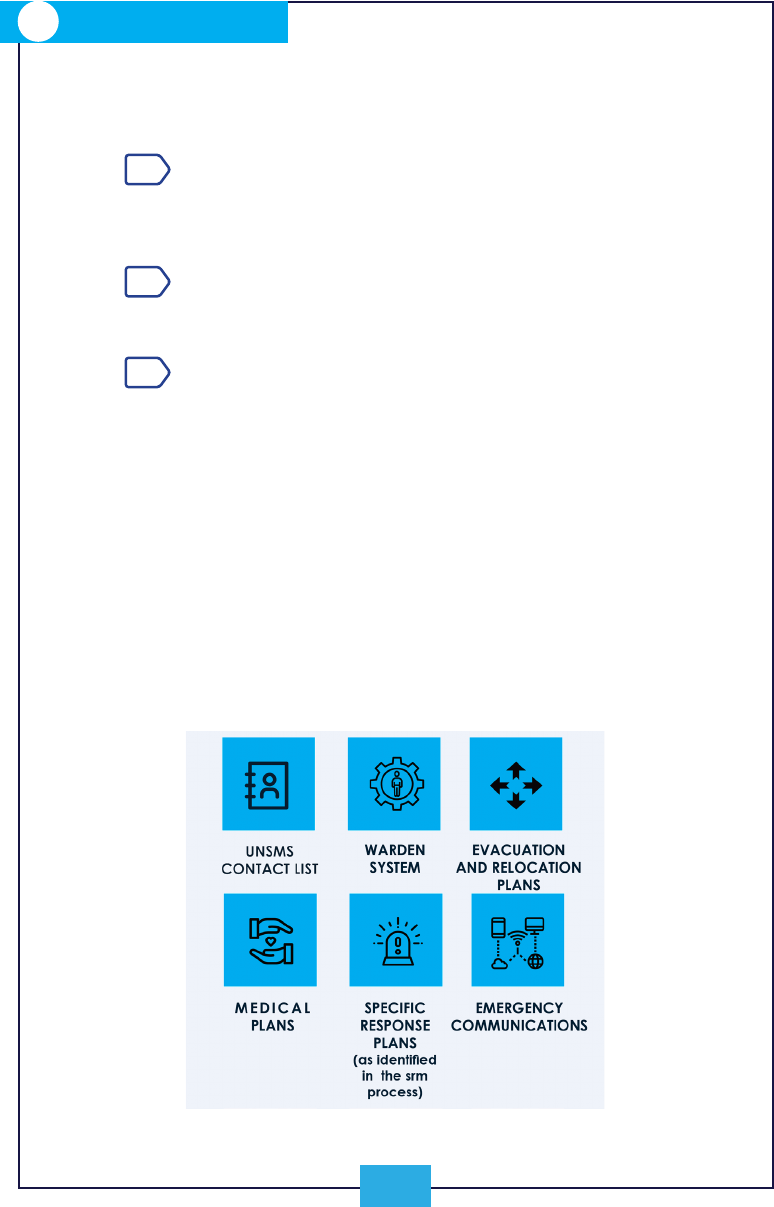
46
DO AND SMT HANDBOOK
3
CRISIS MANAGEMENT
There are three central areas of preparedness:
A timely, updated SRM document identifying likely threat
scenarios, determining security risks and developing and
implementing SRM measures. (See chapter 2 for more on
the SRM).
The security plan, which outlines planned response actions
to address anticipated threat scenarios. (See section below
for more information.)
Crisis management training and exercises, which should be
conducted periodically (at least annually).
Security Planning
The security plans should include security arrangements such as:
updated and veried lists of internationally and locally recruited
personnel and their eligible family members; an emergency
communication system to provide reliable communications
between the DO, the senior UNDSS ocial, the SMT, Wardens
and relevant United Nations oces outside the country, mass
casualty and medical evacuation plans; and the identication
of concentration points and related means of relocation or
evacuation as required.
1
2
3
Fig. 6: The security plan consists of six key components.

47
CRISIS MANAGEMENT
3
DO AND SMT HANDBOOK
Security plans should be regularly maintained and tested,
at minimum on an annual basis. This could be done through
table-top crisis management exercises, evacuation drills and
the activation of warden systems and communications trees.
Exercise scenarios should be built around events and security
threats identied in the SRM process. Preparedness for a range
of contingencies is necessary to ensure an effective response to
crises. ASCs should also test their Area Security Plans at least
as often and, in conjunction, with the country security plan.
While the senior security professional prepares, maintains and
tests Security Plans in collaboration with Security Cells, the DO
has a central role in security planning.
As noted earlier, DOs and UNSMS organizations must include
locally recruited personnel in security planning, and inform them
on what assistance the UNSMS could provide in times of crisis.
The DO:
approves the security plans;
ensures that personnel lists are updated;
liaises with organizations outside the UNSMS;
engages with the Host Government;
approves assistance to other people (outside the UNSMS).
Assistance to other persons
When possible and to the extent feasible, the UNSMS may lend
assistance in a crisis situation for in extremis support. Travel or
nancial assistance will be provided on a space-available and
reimbursable basis. This includes assistance to NGOs covered
under the Saving Lives Together Framework of cooperation
with the United Nations. The DO authorizes the details of this
assistance.

48
DO AND SMT HANDBOOK
3
CRISIS MANAGEMENT
INCIDENTS TARGETING PERSONNEL
AND PREMISES
Increasingly, United Nations personnel and premises have been
targeted directly by a range of hostile threat actors resulting in
injuries, fatalities, impact to programmes or damage to United
Nations facilities. Depending on the seriousness of the incident, the
DO may be required to manage a crisis situation, and/or respond to
post-incident reviews including Boards of Inquiry. With respect to
gender-based security incidents, care should be taken to respect
the response and reporting wishes of the affected personnel. The
UNSMS has promulgated a gender manual which provides more
detailed explanations on how to address gender considerations in
security management.
Where perpetrators of direct attacks against the United Nations
have been identied, the DO needs to pursue further with the
relevant host Government oce to ensure appropriate action is
taken, including police investigations and, where applicable, actions
in accordance with the Convention on the Safety and Security of
United Nations and Associated Personnel.

49
CRISIS MANAGEMENT
3
DO AND SMT HANDBOOK
UNSMS Board of Inquiry
A Board of Inquiry (BOI) is a mechanism to review
investigation reports and record the facts of critical
security incidents involving organizations of the UNSMS,
including whether the occurrence took place as a result
of the acts or omissions of any individual(s). A BOI is
neither an investigative nor a judicial process and does not
make recommendations on questions of compensation,
legal liability or disciplinary action. The purpose of a BOI
is to identify gaps or deciencies in UNSMS SRM policies,
procedures or operations, to strengthen SRM controls
(lessons learned) and to improve accountability for security
risk management. Pursuant to Security Policy Manual
Chapter V, Section E, a BOI may be convened after the
investigators of the affected organizations have completed
their investigation of the incident in accordance with their
applicable legal framework.
Note: The policy covering a UNSMS BOI is different from
those governing BOIs specically for peacekeeping
missions and special political missions. These are triggered
by specic circumstances, which are primarily concerned
with cases of death, injury or kidnapping involving mission
personnel, or major damage or loss of assets owned
by the mission or involving mission personnel. These
circumstances are outlined in the SOP for such BOIs.

SPECIFIC SECURITY
CONSIDERATIONS
4

51
SPECIFIC SECURITY CONSIDERATIONS
4
DO AND SMT HANDBOOK
T
his chapter outlines specic security considerations, including
for those that should be mainstreamed, such as gender, along
with several distinct situations, such as event security and
arrest and detention of personnel.
GENDER AND INCLUSIVITY
United Nations personnel experience different risks. Ensuring that
these diverse risks are included in the SRM is a key responsibility of
the DO and the SMT, as outlined in the Framework of Accountability.
Security operations must be gender-sensitive and gender-responsive
to ensure the safety and security of its entire workforce. The UNSMS
Policy on Gender Inclusion in Security Risk Management outlines
requirements that must be considered at different stages of the SRM
process. The aim is to ensure that specic gender-based threats or
measures are identied and appropriately included in all security
planning.
• All incoming security briengs must include gender-specic
threats, risks and related mitigation measures in the duty
country.
• Residential security measures and contingency plans must
be reviewed to ensure they are gender inclusive.
• The SRM in each country must address gender at each
stage of the process, ensuring appropriate and effective
mitigation measures are identied and implemented.
• All UNSMS personnel must complete the ‘I Know Gender’
training course.
• All locations must develop an aide-memoire providing
guidance to personnel on available resources in the event of
a gender-based security incident.
Applying a gender lens throughout the SRM process is critical to
ensuring that gender perspectives are captured and addressed.

52
DO AND SMT HANDBOOK
4
SPECIFIC SECURITY CONSIDERATIONS
Gender-based security incidents¹, including sexual violence, may
occur against internationally and locally recruited United Nations
personnel in your area of responsibility. In response to these serious
incidents, security personnel are guided by core principles, including,
but not limited to: the identication of, and transfer to, a safe space,
if requested by the affected person; provision of expert medical and
psychosocial services if required; and strict condentiality. This
information should be consolidated by UNDSS and the Security
Cell in the aide-memoire for responding to a gender-based security
incident. Where available, gender experts in-country or regionally
based can be consulted to provide input on specic gender and
security-related risks, hence ensuring that these are appropriately
integrated into the SRM. A Manual on Gender Considerations in
Security Management, published in 2019, offers practical advice for
security professionals.
1 Gender refers to the attributes, opportunities and relationships associated with being
male or female, including lesbian, gay, bisexual, trans-gender and inter-sex (LGBTI) individuals.
Attitudes to sexuality and the expressions of gender and
sexual orientation vary from one country to another. Some
may be instilled from a political level; others may be based
on traditions, religious, cultural and societal norms. At the
United Nations, human rights apply equally to all people
regardless of their sexual orientation, gender identity
and expression and sex characteristics (more commonly
referred to as SOGIESC) in just the same way as they do to
age, race and religion.

53
SPECIFIC SECURITY CONSIDERATIONS
4
DO AND SMT HANDBOOK
DISABILITY CONSIDERATIONS
The SRM process should be inclusive of disability considerations,
from situational analysis, specic threat assessment and security
risk assessment to the identication of SRM measures. Within UN
premises, the prevention and mitigation measures should respond
to disability-based security risks. Security plans and movements
such as duty travel or relocation should also cater to disability
considerations.
LOCALLY RECRUITED PERSONNEL
All UNSMS policies apply to all United Nations personnel, regardless
of contract type. As with internationally recruited personnel, the
security of locally recruited personnel is managed through the
SRM process. Locally recruited personnel may be operating in
areas where their ethnicity or origins require specic attention,
particularly in cross-line operations. These additional risks must be
considered in the SRM.
In addition, tasks cannot be randomly reassigned from one
category of personnel to another without adequate justication.
If tasks are assigned to locally recruited personnel because risk
to internationally recruited personnel is unacceptable, the SRM
process must demonstrate that risk to locally recruited personnel
falls within acceptable levels. To note, locally recruited personnel
and family can only be evacuated in exceptional circumstances, and
by the decision of the Secretary-General. The personnel and their
families may, however, choose to be internally relocated.

54
DO AND SMT HANDBOOK
4
SPECIFIC SECURITY CONSIDERATIONS
ABDUCTION OF PERSONNEL
As the organizations of the UNSMS are increasingly called
upon to operate in insecure areas, the UNSMS has developed a
comprehensive policy, along with targeted guidelines and training,
for managing hostage incidents. The UNSMS policy on hostage
incident management stipulates that the Organization will not pay
ransom nor make any substantial concessions to hostage takers,
nor shall it intervene with Member States to make exchanges
for hostages. Ransom or other concessions for the release of a
hostage encourage potential hostage-takers and thus increase the
danger that other personnel might face in the future.
In the event of a hostage-taking incident, the DO is responsible for
establishing a team to manage the incident, securing the speedy
and safe release of the hostage(s), including contacting the host
Government authorities and reviewing security measures to
determine if they should be enhanced. UNDSS will send trained
experts in hostage incident management if there are none in your
Designated Area.
The USG UNDSS will take the necessary decisions and ensure a
coherent response by the United Nations. Please see the chapter on
Crisis Management for more information on response during safety
and security crises, which include hostage incidents.
An international contractor from India (second from left) working with the African
Union-United Nations Hybrid Operation in Darfur (UNAMID), is welcomed at El Fasher
Airport. He had been abducted in El Fasher, North Darfur./UN Photo

55
SPECIFIC SECURITY CONSIDERATIONS
4
DO AND SMT HANDBOOK
ARREST AND DETENTION OF
PERSONNEL
United Nations personnel must respect the laws and regulations
of the host Government and refrain from any action or activity
incompatible with the impartial and international nature of their
duties². United Nations international and locally recruited personnel
may be subject to arrest and detention by government authorities
due to infringement of host Government(s) laws and regulations.
United Nations personnel have also been arrested or detained
without due cause.
In the event of arrest of United Nations personnel, the DO is required
to immediately contact the host Government Foreign Ministry
or relevant government oce and request information about the
arrest or detention and charges concerned, and request access as
soon as possible for a United Nations ocial and, as appropriate,
a physician. The DO may also underscore the host Government’s
responsibilities for United Nations personnel to be treated in
accordance with universally recognized standards of human rights
and the principles of the Geneva Conventions of 1949. The DO must
also notify the USG UNDSS.
As the organizations comprising the UNSMS are, in some cases,
subject to different legal regimes governing their status, privileges
and immunities, the employing organization shall determine what
additional action may be required in accordance with its legal
status and applicable legal instruments.
2 See Staff Rules and Regulations of the United Nations (ST/SGB/2016/1), Art. 1, Regulation
1.1(f ); Art. 1, Regulation 1.2(f ); Art. 1, Regulation 1.2(m); Chapter 1, Rule 1.2(b); and Chapter 1, Rule
1.2(q)

56
DO AND SMT HANDBOOK
4
SPECIFIC SECURITY CONSIDERATIONS
PHYSICAL SECURITY
In response to an increase in attacks specically against United
Nations premises (buildings, oces, storage facilities), UNDSS has
created a Physical Security Unit to ensure expertise on physical
protection is provided to DOs and to the entire UNSMS. The core
functions of the Physical Security Unit include:
(a) Conducting physical security assessments of UNSMS
premises and assisting in the implementation of physical
security risk management measures in UNSMS premises;
(b) Conducting blast vulnerability assessments and
recommending security risk management measures related
to blast threats at United Nations Security Management
System premises;
(c) Preparing standards and guidelines on physical security
equipment, designs, knowledge management content,
research material and training programmes;
(d) Collaborating with technical experts and security focal
points of UNSMS entities on physical security.
Many United Nations premises are provided by Member States or
rented by UNSMS organizations and are not built primarily with
security and safety considerations in mind. If so determined by the
SRM process, and without abrogating the responsibility of the host
Government for the security of United Nations premises, additional
security measures for premises may be implemented by the UNSMS
beyond those provided by host Governments.
Organizations of the UNSMS are responsible for providing adequate
funding to meet their premises security needs. Organizations
of the UNSMS may also implement additional SRM measures
for their respective premises, as they determine appropriate.
Lastly, common premises shared by UNSMS organizations are
an important component of the Secretary-General’s UN Reform
Programme. Common premises aim to build closer ties among
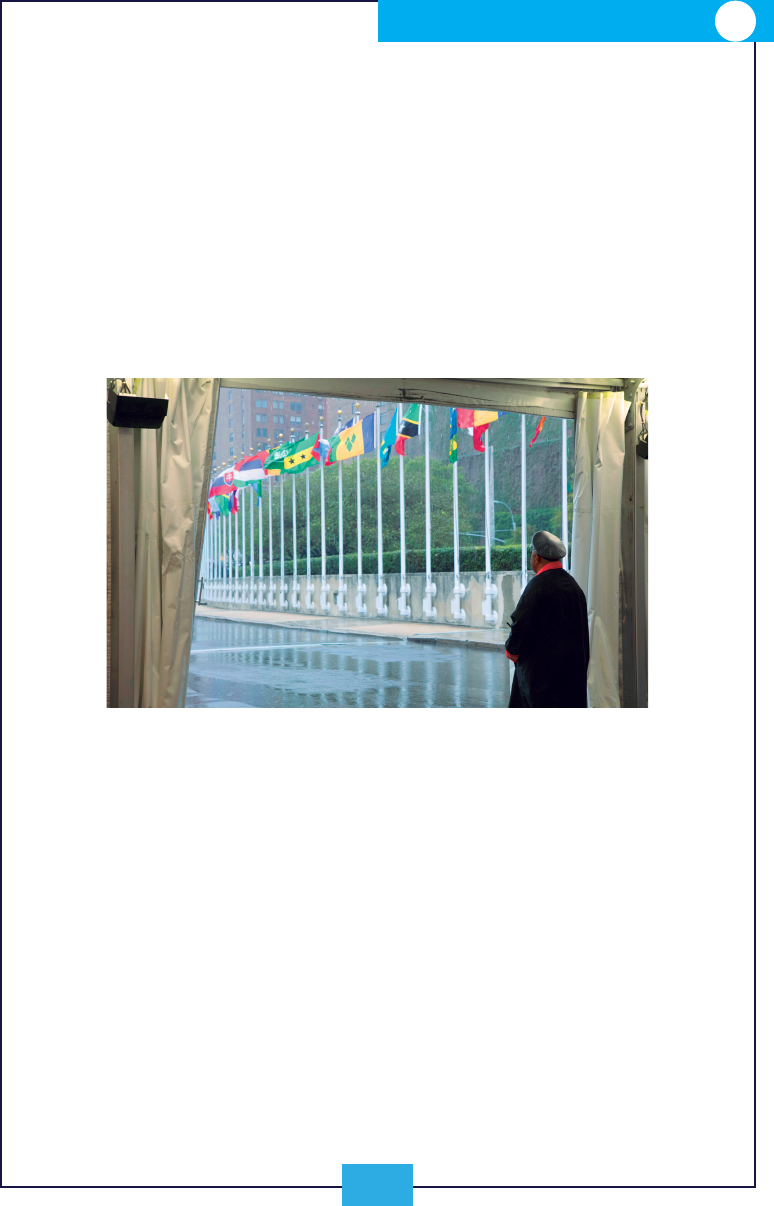
57
SPECIFIC SECURITY CONSIDERATIONS
4
DO AND SMT HANDBOOK
UNSMS personnel and promote a more unied presence at
country level in a cost-effective manner. In most cases, security
management oversight of common premises is the responsibility of
the senior UNDSS representative, though in some cases, a security
professional of a UNSMS organization may undertake the role.
Guidelines on Security Management of UN Premises have been
produced to clarify roles and responsibilities on the issue.
EVENT SECURITY
A UNSMS organization may hold an event or conference in your
Designated Area. These events can attract large numbers of
United Nations personnel and other participants in venues that are
normally not under the organizational control of the UNSMS.
The UNSMS organization sponsoring or organizing an event or
conference is responsible for notifying the DO in advance of any
planned event in the Designated Area, including information on the
expected numbers of attendees and proles of the event and invited
guests. In consultation with the SMT and UNDSS in-country and at
headquarters, and based on the conclusions of an event-specic
SRM process, the DO may determine whether additional security
capacity and/or specialized assistance for this event is required,
and provide clearance for the event to proceed.
A UNDSS ocer awaits arriving delegations on the rst day of the General Assembly’s
seventy-third general debate./UN Photo

58
DO AND SMT HANDBOOK
4
SPECIFIC SECURITY CONSIDERATIONS
The sponsoring United Nations organization shall make necessary
arrangements and provide required nancial resources to comply
with the required SRM measures.
PROTECTIVE SECURITY SERVICES
In the course of their duties, senior United Nations ocials may be
subject to increased threat due to their higher visibility, leadership
roles in the implementation of specic mandates and programmes
or prior service.
Senior United Nations ocials may face additional threats in
situations where they have issued statements or undertaken
actions against various threat actors, or represent positions
contrary to the aims of such groups. UNDSS personnel identify
and assess these threats through an SRM process. Based on the
outcome of this, senior United Nations ocials may be provided
with protective services, usually coordinated with, or provided by,
the host Government. In rare situations, as the senior representative
in-country, the DO may exceptionally receive protective services
on the advice of UNDSS during travel in country or during periods
of heightened risk. The Division of Security and Safety Services
is responsible for the setting of standards and coordination of
protective security services throughout the UNSMS.
CBRN
Chemical, Biological, Radiological, and Nuclear (CBRN) events are
actions or occurrences that may lead to the release or dispersal
of hazardous materials. The UNSMS CBRN policy addresses the
deliberate release of a CBRN agent, which may be conducted by
States, Non-State Armed Groups, criminal groups or individuals. It
may result in hazardous conditions in the operating environment,
such as contaminated air or water.

59
SPECIFIC SECURITY CONSIDERATIONS
4
DO AND SMT HANDBOOK
Where the risk of a CBRN event is unacceptable (very likely and
critical impact or compared with programme criticality), risk
avoidance is required. UNSMS organizations will not undertake
or continue operations in an environment where CBRN attacks are
occurring or have occurred. Personnel from entities with mandates
to operate in environments with CBRN hazards are exempt from
this, if their training and equipment lower the likelihood and/or
impact, making the risk acceptable.
The threat of CBRN attacks is addressed through the SRM
process. The primary responsibility for response rests with the
host Government. However, if the host Government capacity is
inadequate, the DO should request from the USG UNDSS strategic
interventions at the appropriate level. If warranted, the DO should
also consult with the USG UNDSS on acquiring CBRN technical
expertise. Expert resources could be sought, primarily from
specialised UNSMS organisations, Member States and other
international organizations.
Fig. 7: CBRN threats may consist of any of the above components.
Chemical
Naturally occurring or man-made
toxic substances used in daily life,
industry and medicine, or for law-
enforcement/military purposes.
Radiological
Radioactive materials occurring
naturally, as by-products in industrial
processes or manufactured for use in
industry or medical therapy.
Biological
Naturally occuring or genetically
altered microorganisms (viruses,
fungi and bacteria) and toxins
(poisonous chemicals produced by
biological organisms).
Nuclear
Radioactive materials generated by
nuclear ssion or fusion, such as those
associated with nuclear power plants
or with the detonation of a nuclear
weapon.
CBRN Components

60
DO AND SMT HANDBOOK
4
SPECIFIC SECURITY CONSIDERATIONS
PSYCHOSOCIAL SUPPORT
The conditions under which United Nations personnel operate
have changed drastically over the years. This has substantially
increased the number of personnel exposed to stress, particularly
critical incident stress, the Critical Incident Stress Management
Unit (CISMU), coordinates with counsellors of other UNSMS
organizations and provides psychosocial services and counselling
to those who are at risk of experiencing stress, including critical
incident stress.
CISMU, with counsellors of other UNSMS organizations, also delivers
a range of supporting services including assessing psychosocial
status and needs of United Nations personnel and dependents
in the duty station, identifying and training local counsellors, and
conducting peer helper training.
DOs and SMTs should ensure that personnel in the Designated
Areas are fully aware of CISMU’s services, and encourage personnel
to make use of these services as appropriate, but particularly in
the event of a critical security incident. DOs and SMTs are also
encouraged to make use of CISMU’s services as a resource to aid
their own understanding of the concerns, stressors and challenges
to the well-being of personnel in the Designated Area, in line with
relevant condentiality provisions.
SRM measures for CBRN threats
SRM measures for CBRN threats could include alternate
work modalities, awareness programmes for personnel,
and planning for the mitigation of assessed, specic CBRN
risks.

61
SPECIFIC SECURITY CONSIDERATIONS
4
DO AND SMT HANDBOOK
SECURITY OF IMPLEMENTING
PARTNER NGOS
Personnel of international NGOs in Designated Areas do not fall
under the scope of the UNSMS in accordance with the UNSMS
Applicability Policy. However, security collaboration between
the UNSMS and implementing partners is important to enable
programme delivery at the country or mission level.
Saving Lives Together is a framework for security collaboration
between the UNSMS and NGOs, both national and international.
It provides for the convening of forums in the Designated Area
for security collaboration and information-sharing as well as
establishing partnerships for training, emergency responses to
security situations or consolidated security related resources.
The DO and the SMT are encouraged to promote the principles of
the Saving Lives Together framework and implementing measures
identied in this policy, within available resources.
SECURITY COMMUNICATIONS
Security communications have changed over the years due to
advances in technology. The UNSMS has evolved its security
communications approach to support the overall security needs
under all circumstances, not only in emergencies. Therefore,
“Emergency Communications Systems” supported by conventional
radio rooms are replaced by “Security Communications Systems”
supported by Security Operations Centres.
To support these changes through new standards, an inter-
agency collaborative project - the “Telecommunications Security
Standards” (TESS) project - commenced in 2018. In 2020, this
project was converted into a continued service called “{TESS+}”.
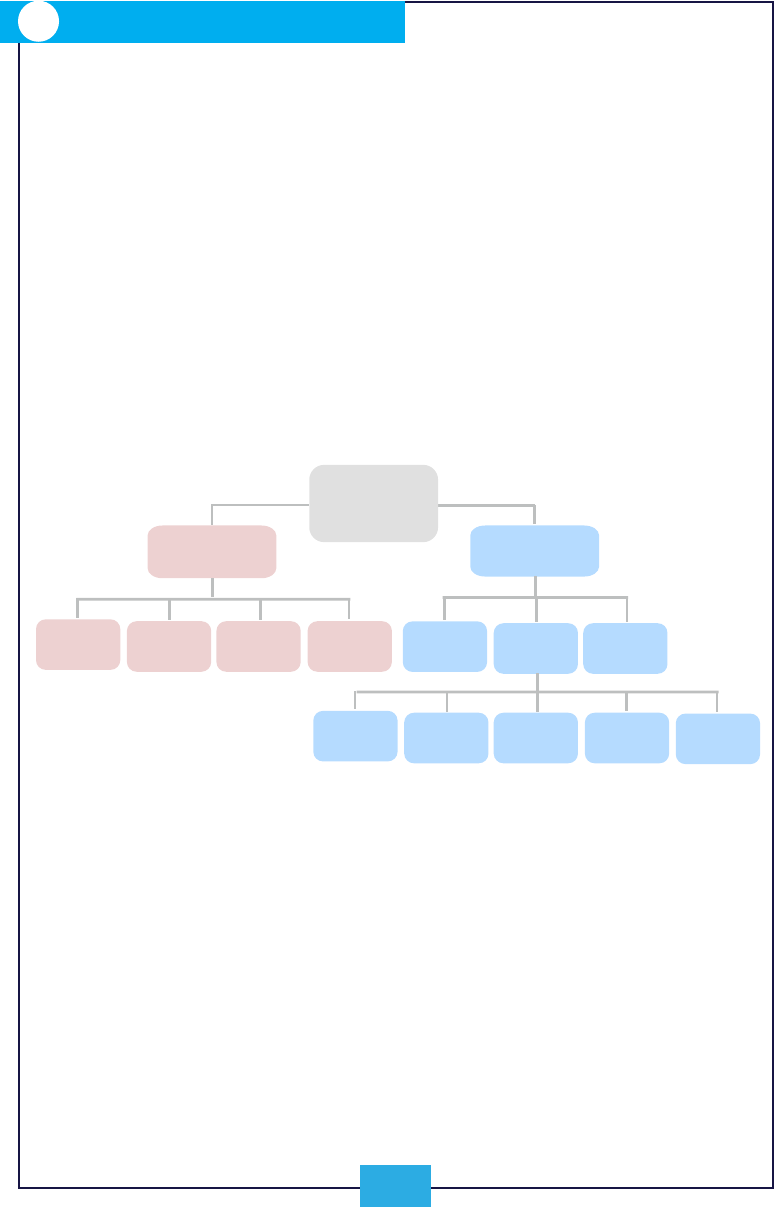
62
DO AND SMT HANDBOOK
4
SPECIFIC SECURITY CONSIDERATIONS
At country level, the nal decision on security communications rests
with the DO, supported by the SMT, and should be included in the
country’s SRM. As part of the security planning arrangements, the
most senior security professional advises the DO in identifying the
appropriate security communications systems for each operational
area. This is done in consultation with the Security Cell, the SMT
and the local IT Working Group and supported by the TESS team.
SAFETY
The SRM process distinguishes security from safety. Security is
related to undesirable events deliberately caused by people, while
safety is related to undesirable events that are not deliberate,
such as natural disasters. The UNSMS has a remit for three areas
of safety: road safety, re safety and aviation safety. There are
therefore many other areas of safety not covered by the UNSMS,
including some occupational health and safety (OSH) issues
such as workplace safety. The above schematic shows a simple
classication of security threats versus safety (or OSH) hazards.
Fig. 8: Harmful events are classied into security threats or OSH hazards.
DELIBERATE?
SECURITY
THREATS
OSH
HAZARDS
ARMED
CONFLICT
TERRORISM
CRIME
CIVIL
UNREST
NATURAL
HAZARDS
ACCIDENTAL
HAZARDS
HEALTH
HAZARDS
HAZMAT
AVIATION
ROAD
TRAFFIC
FIRE
WORKPLACE
SAFETY
YES
NO
HARMFUL EVENTS: THREATS OR HAZARDS?
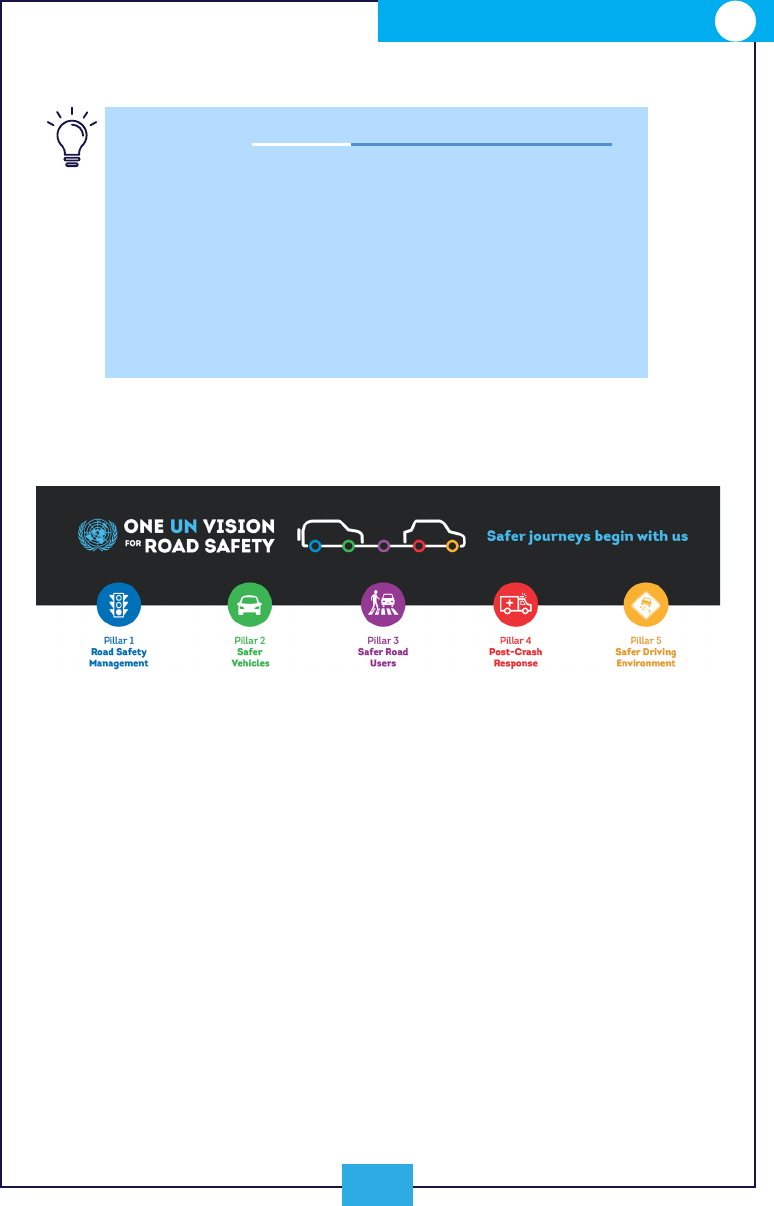
63
SPECIFIC SECURITY CONSIDERATIONS
4
DO AND SMT HANDBOOK
Road Safety
Road and vehicle-related crashes are a common cause of
injury and death among United Nations personnel and others.
Poor road safety practices are not only a danger to drivers,
passengers and other road users, but also impede the ability
of the organization to implement its programmes and can
adversely affect acceptance and generate resentment within
the local population towards the United Nations. The UNSMS is
working across its member organizations to ensure a consistent
and cohesive approach to road safety is taken across the United
Nations.
OSH at the UN Secretariat
Within the UN Secretariat, a dedicated Division of Health
Management and Occupational Safety & Health (known as
DHMOSH) has been established. The new division, part of
the Department of Operational Support, aims to integrate
Secretariat safety risk management programmes and
safety categories under one OSH risk management
system. For more information, please see unosh.org or
email osh@un.org.
Fig. 9: The UN Road Safety Strategy has ve inter-linked pillars.

64
DO AND SMT HANDBOOK
4
SPECIFIC SECURITY CONSIDERATIONS
Fire Safety
The UNSMS has established basic re prevention principles, as
well as guidance on preparation and response, in order to minimize
the risk from re to personnel, assets and operations. The DO is
responsible for ensuring the establishment, implementation and
annual review of all Fire Safety Plans within the Designated Area.
A UNDSS ocer instructs a staff member on the use of a re extinguisher during a
Safety and Security Week demonstration at UN Headquarters./UN Photo
“Safer Journeys Begin with US”: The UN-Wide Road Safety
Strategy
In 2019, the UN Road Safety Strategy was launched to curb road
crashes. In line with SDG 3.6, the approach aims to halve the
number of UN personnel and other road users killed or seriously
injured in road trac crashes involving UN vehicles. The aim of
the strategy is to provide a commitment from all United Nations
organizations to a single vision and agreed set of objectives
and actions that focus on: improved road safety management,
safer vehicles, safer road users, improved post-crash response
and safer driving environments within UN premises. The United
Nations is engaged in developing a pro-active, cross-sectoral
and forward-looking approach to road safety which requires
instilling a safety culture in the Organization, while managing
the interaction between speed, vehicles, road infrastructure and
human behaviour in a holistic manner.
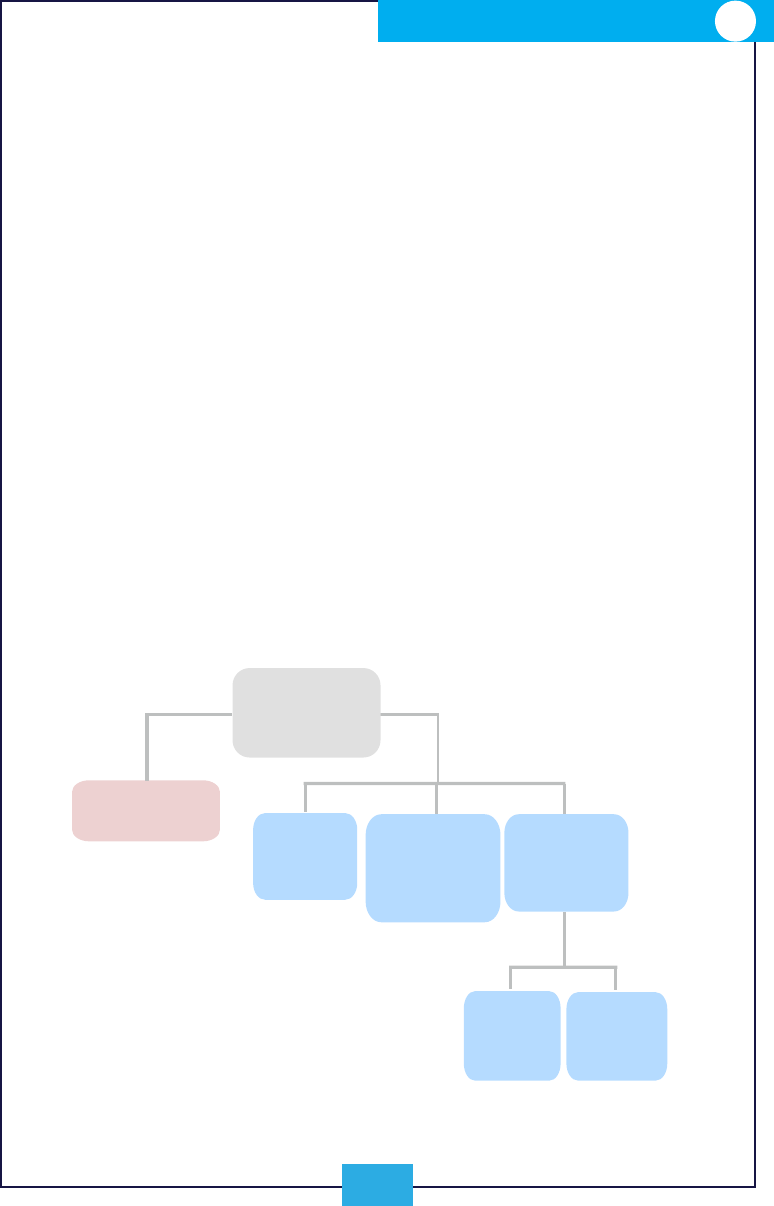
65
SPECIFIC SECURITY CONSIDERATIONS
4
DO AND SMT HANDBOOK
AIR OPERATOR ON
RECOMMENDED
LIST?
(ON UNSMIN)
USE
AIR OPERATOR
USE AIR
OPERATOR;
INFORM SMT
USE
ALTERNATIVE
MODE OF
TRAVEL
(ROAD, UN AIR ASSETS, ETC.)
REQUEST
ADDITIONAL
SUPPORT FROM
CATSU
EXPANDED
TECHNICAL
REVIEW
ON-THE-
GROUND
ASSESSMENT
YES
NO
SIMPLIFIED DECISION-MAKING PROCESS FLOW
Aviation Safety
UNDSS, through the Commercial Air Travel Safety Unit (CATSU),
provides members of the UNSMS with information and guidance
regarding the suitability of commercial air operators for use
worldwide.
Each UNSMS entity makes decisions on the use of commercial
air operators and donated ights for their personnel. To facilitate
their decisions, CATSU provides a single list of recommended
air operators to authorized users, as per the new Commercial Air
Travel Safety Policy promulgated in 2019. UNSMS entities may
request additional support from CATSU, including expanded
technical reviews and/or on-the-ground assessments of air
operators.
The chart below identies the options that UN entities should
consider for circumstances where there is no recommended
commercial air operator available. In an emergency situation,
the DO has the authority to approve the use of any air operator,
to ensure safety and security of UN personnel.
Fig. 10: The decision-making process ow for commercial air travel safety

SECURITY
ADMINISTRATION
5
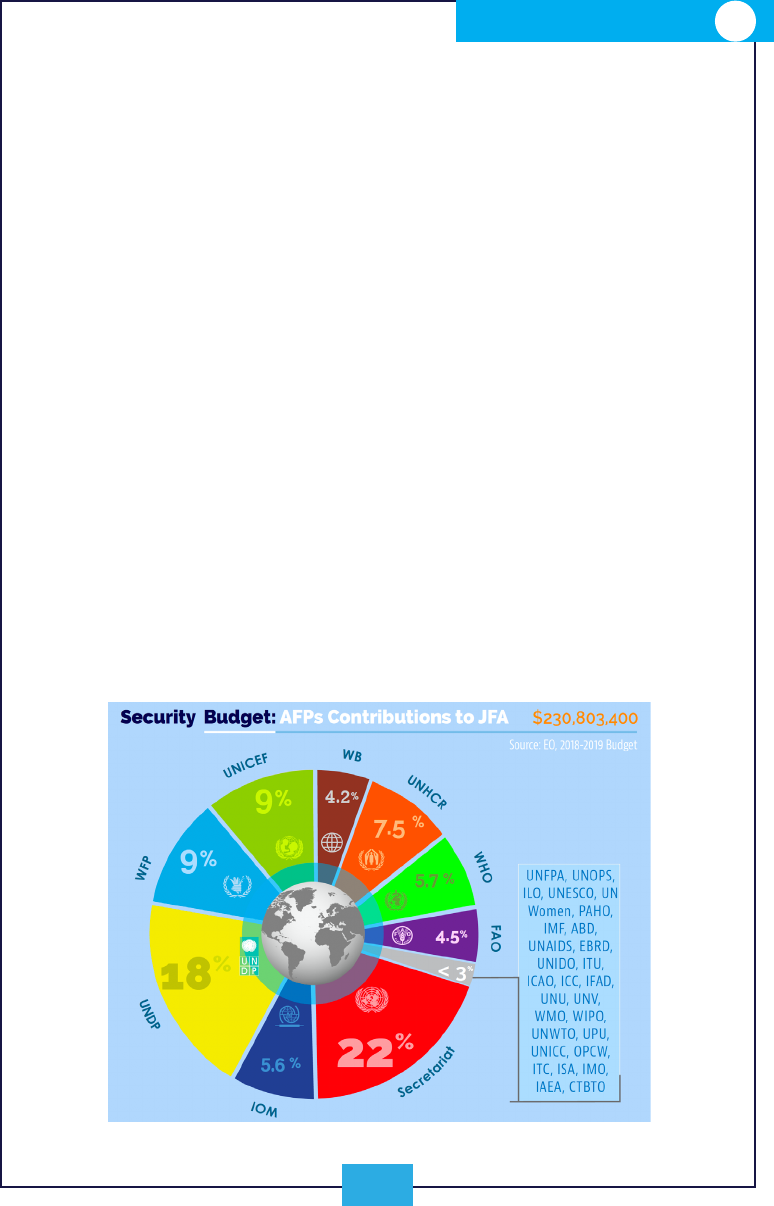
67
SECURITY ADMINISTRATION
5
DO AND SMT HANDBOOK
T
his nal chapter outlines some administrative guidance
on security budgets, the determination of duty station
classications and the supervision of security personnel in
the Designated Area.
SECURITY BUDGETS
Budgets for security personnel, equipment and services are a
necessary and important element of ensuring a sustainable and
reliable security management system.
At the local level, there are different sources of funding for safety
and security activities; each has a different goal and responds to
different budgetary rules.
Each UNDSS eld oce receives an Authorized Spending Limit and
eld operational budget funded by Jointly Funded Activities (JFA).
These cover authorized positions and General Operating Expenses.
In peace missions, missions’ security ocers stang, training and
activities are supported by the mission’s budget. In addition, extra-
budgetary funding may support specic programme activities.
Fig. 11: JFA Security Budget for 2018-19
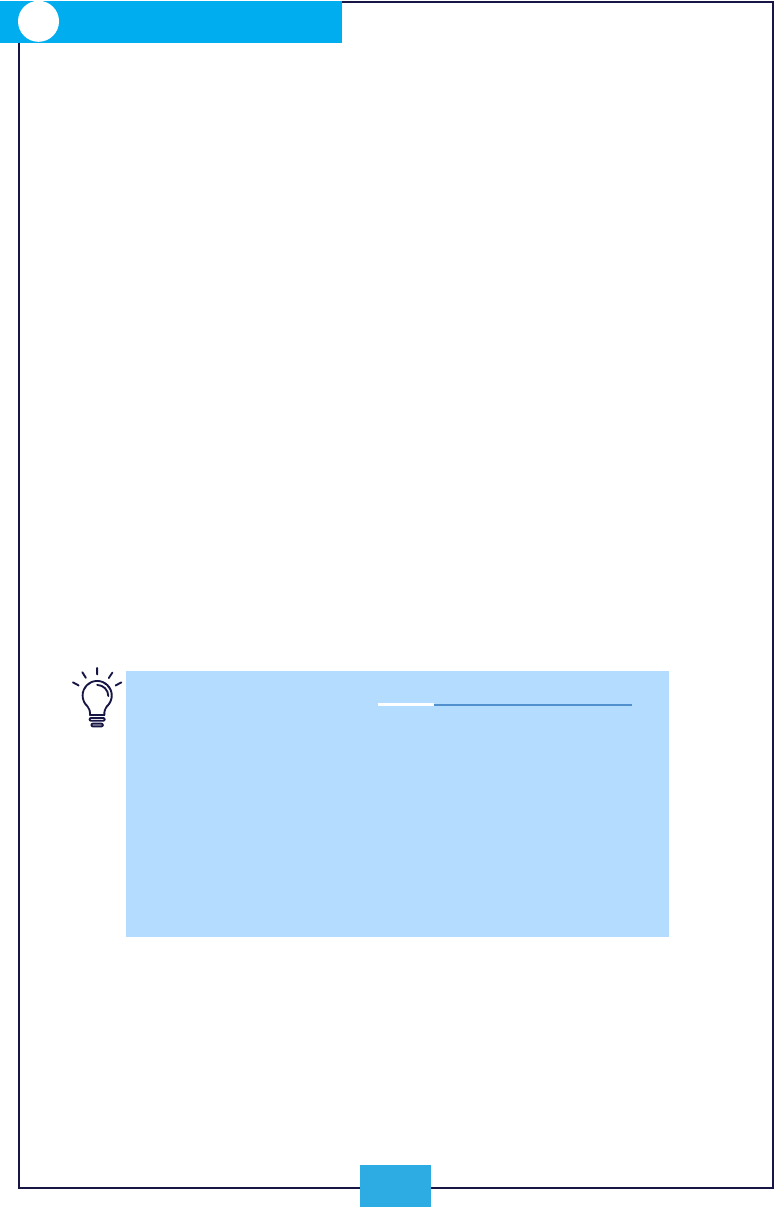
68
DO AND SMT HANDBOOK
5
SECURITY ADMINISTRATION
In addition, a Locally Cost-Shared Security Budget (LCSSB) can be
established and approved by the DO, in consultation with the SMT,
to cover the common local security needs.
The LCSSB
The LCSSB aims to address common security concerns at the
country/area level that are not funded through other sources.
These costs are shared among UNSMS organizations based
on local headcount. UNDSS is exempt of the contribution to the
LCSSB as per the HLCM’s decision decision.
The LCSSB submission must be based on measures identied
in the SRM process. It is distinct from UNDSS activities funded
by the JFA. Eight types of activities may be funded: identication
programme, security operational support, communications
structure, security training, crisis coordination centre, guard
force, psychosocial support and vehicle requirements.
Organizations outside of the UNSMS should not be contributing
to the LCSSB. While an administering agency oversees the
nancial status of the LCSSB, the budget is prepared and
overseen by the P/C/SA.
The process consists of ten steps, as shown on the following
diagram.
The main principles of the LCSSB
Meant for common security needs and supports SRM
measures identied through the SRM process approved
by the DO/SMT. SMT members should consult with their
Security Focal Points (SFPs) prior to approval.
Consolidated at country level
Includes both capital and recurring costs
Cost-effective

69
SECURITY ADMINISTRATION
5
DO AND SMT HANDBOOK
Fig. 12: The LCSSB process
Step one
Establishment of SRM
01
02
03
Step four
Consultation of SFPs
04
Step five
Approval by the DO/SMT
05
Step six
Notification by DRO
06
07
Step eight
Billing
08
Step nine
Payment
09
Step ten
Budget execution
10
Step seven
Finalizing LCSSB data on UNSMIN
Step three
Review by UNDSS/DRO Desk Officers
Step two
Preparation of LCSSB & review
by the SMT

70
DO AND SMT HANDBOOK
5
SECURITY ADMINISTRATION
Additional Resources
The DO may request additional security capacity in their
Designated Area through the surge programme in the following
circumstances/situations:
• Security emergencies and crisis situations
• Reinforcement of UNDSS capacity in the eld or at HQs
• Temporary security coverage of additional eld locations
• Security support in response to humanitarian emergencies
• Hostage takings /abductions
• Other requirements - as directed by the USG UNDSS or
Director/Deputy Director DRO.
As UNDSS does not have a ‘standing’ capacity, the surge
deployment programme uses existing resources of UNDSS,
DPO, DOS or DPPA and other UNSMS organizations.
Regular surge requests that are funded from the JFA should be
addressed to the respective Regional Section of DRO for review
and endorsement.
Surge requests that are funded through extra-budgetary security
projects are to be addressed to the DRO Operations Ocer.
DUTY STATION CLASSIFICATION
Duty station classications are administered by non-security
bodies, although the DO and the SMT should be familiar with the
processes.
Most of the United Nations organizations’ work is done in the eld
and often in duty stations where living and working conditions
are dicult. This is recognized through a system whereby duty
stations are accorded a classication of A to E that denotes the
overall quality of life at a particular duty station, with A signifying
the lowest level of hardship. Based on the hardship level, personnel
may receive a hardship allowance to compensate for the dicult
living conditions. The classication is determined by a working

71
SECURITY ADMINISTRATION
5
DO AND SMT HANDBOOK
group of the International Civil Service Commission (ICSC) and
based on the outcomes of a questionnaire issued to the UNCT. In
determining the degree of hardship, consideration is given to local
conditions of safety and security, health care, education, housing,
climate, isolation and the availability of basic amenities. Thus,
security forms one component of the overall hardship assessment.
While ICSC reviews are conducted once every three years on a
regional and rotational basis, some duty stations are reviewed
more frequently, such as those with a dicult or volatile security
situation. (More information can be found on the ICSC website:
http://icsc.un.org).
DANGER PAY
Danger pay is a special allowance established for internationally and
locally recruited staff who are required to work in locations where
very dangerous conditions prevail. The DO may submit a request for
danger pay to be introduced for a particular area to the USG UNDSS,
in strict conformity with established ICSC criteria¹. Submissions
to the USG UNDSS must include the relevant SRM process and a
thorough and detailed analysis of the prevailing security situation in
the specic duty station.
Although requests are submitted through the USG UNDSS, the Chair
of the ICSC, under delegated authority from the Commission, takes
the nal decision. The application of danger pay must be reviewed
every three months following the same process.
1 The criteria are: (1) Duty stations where UNSMS personnel and premises are targeted
owing to their association with, or employment by, UNSMS organizations; (2) Duty stations where
UNSMS personnel are at high risk of becoming collateral damage in a war or active armed conict; (3)
Non-protected environments where medical personnel are at risk when deployed to deal with public
health emergencies.

72
DO AND SMT HANDBOOK
5
SECURITY ADMINISTRATION
ROLE OF SENIOR UNDSS
REPRESENTATIVE
The senior UNDSS representative (P/C/SA) serves as the primary
adviser to the DO on all aspects of security management, crisis
readiness and preparedness in the Designated Area. It is important
that the DO extends effective management and oversight of the
senior UNDSS representative through the following:
• Maintain a direct communication line with the senior UNDSS
representative and hold regular meetings with him/her to
receive security advice on any security management issues.
• Direct and oversee the implementation of SRM by the senior
UNDSS representative as well as UNSMS policies and
procedures at the Designated Area.
• Ensure the senior UNDSS representative is included in UNCT
management meetings, working groups and decision-making
bodies, as appropriate, in order to ensure the integration of
security in country-wide planning and programmes.
• Introduce the senior UNDSS representative to host Government
ocials to ensure security liaison and collaboration with focal
points at the working level who have been designated by the
senior national authorities.
• Conduct objective evaluations and provide regular feedback to
UNDSS on the performance of the senior UNDSS representative.

73
SECURITY ADMINISTRATION
5
DO AND SMT HANDBOOK
ARMING OF SECURITY
PROFESSIONALS
Under exceptional circumstances, the DO, in consultation with the
SMT, may request the arming of security personnel for a limited
duration in order to undertake specic protection functions. The
authorization for this is provided by the USG UNDSS following a
stringent approval process. Nevertheless, senior security personnel
remain, above all, security advisers.
Other Security Professionals
The DO should make sure that single-agency professionals
are duly integrated in the management of security in the
Designated Area and able to participate at the dedicated
fora (e.g. Security Cell/working groups, coordinated by the
most senior UNDSS representative), as per policy.
UN Secretariat Safety and Security Integration
UN security personnel serving in UN peacekeeping missions
and Special Political Missions fall under UNDSS oversight
and management. This does not apply to security personnel
who are employed by other UNSMS organizations.
For more information on the various authorities related to
budget, nance, recruitment, training, security management,
logistics and procurement, please refer to the Secretary-
General’s memo dated 28 December 2016 and Security
Integration Guidelines Update 2020. (The documents are
available on unsmin.org.)

74
DO AND SMT HANDBOOK
5
SECURITY ADMINISTRATION
UNDSS ORGANIZATION CHART
Fig. 13: UNDSS Organization Chart
Executive
Office
Division of
Security & Safety Services
Security for Special Events
Security and Safety Services for HQ
Offices Away from HQs
Regional Commissions
International Tribunals
Under-Secretary-General
Assistant Secretary-General
Office of the Director
Critical Incident Stress Management Unit
Protection Coordination Unit
Physical Security Unit
Training and Development Section
Strategic Planning
and Policy Service
Strategic Planning
Strategic Communications
Evaluation & Compliance Monitoring
Gender Equality & Inclusivity
Policy
Division of
Specialized Operational Support
Division of
Regional Operations
Threat & Risk Assessment Service
Communications Centre
Peacekeeping Operations Support Section
Regional Sections:
Middle East & North Africa
Asia-Pacific
Africa
Europe & Americas
Office of the USG
Front Offices
Human Resources
Budget and Finance
Logistics
General Administration
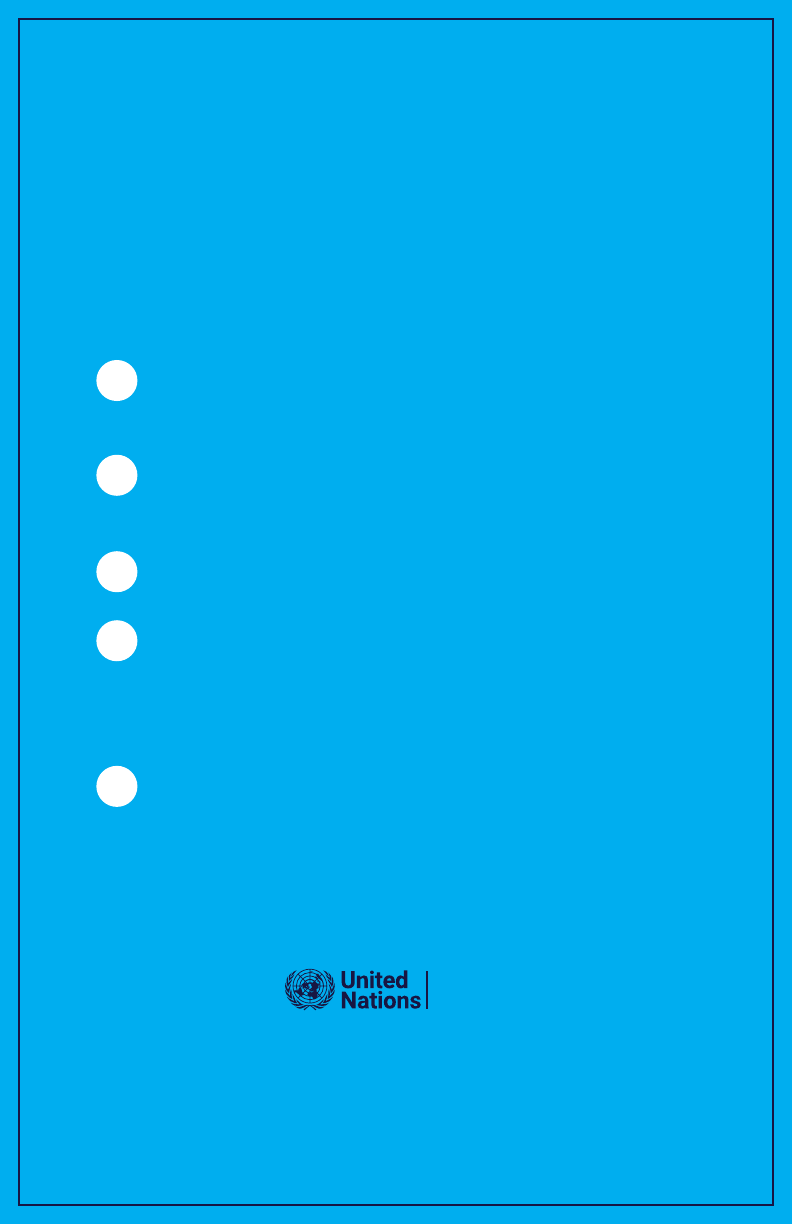
The DO and SMT Handbook: A Guide for Designated Ocials for Security
and Security Management Teams (New Edition) is a handy reference to the
policy and security management framework provided by the United Nations
Security Management System. The handbook was updated in 2020 to reect
new policies and other recent guidance, and includes a new chapter on crisis
management.
The handbook is divided into ve main chapters that cover the most
important aspects of these security functions.
Legal and Policy Framework describes the United Nations and
UNSMS policy framework that supports the DO and the SMT in the
discharge of their duties.
Operational Guidance focuses on the day-to-day operational roles of
the DO and the SMT, particularly those responsibilities relating to the
Security Risk Management process.
Crisis Management focuses on the planning and response during a
crisis situation, and includes practical guidance such as checklists.
Additional Security Considerations addresses additional security
considerations that DOs and SMTs must take into account,
such as the inclusion of gender in security management, as well as
specic situations like safety-related issues and arrest and detention
of personnel.
Security Administration provides guidance on administrative issues
related to security, such as security budgets and the supervision of
security personnel.
https://www.un.org/undss
Published by UNDSS, September 2020
To request additional copies, please email [email protected]
1
2
3
4
5
Department
of Safety
and Security
